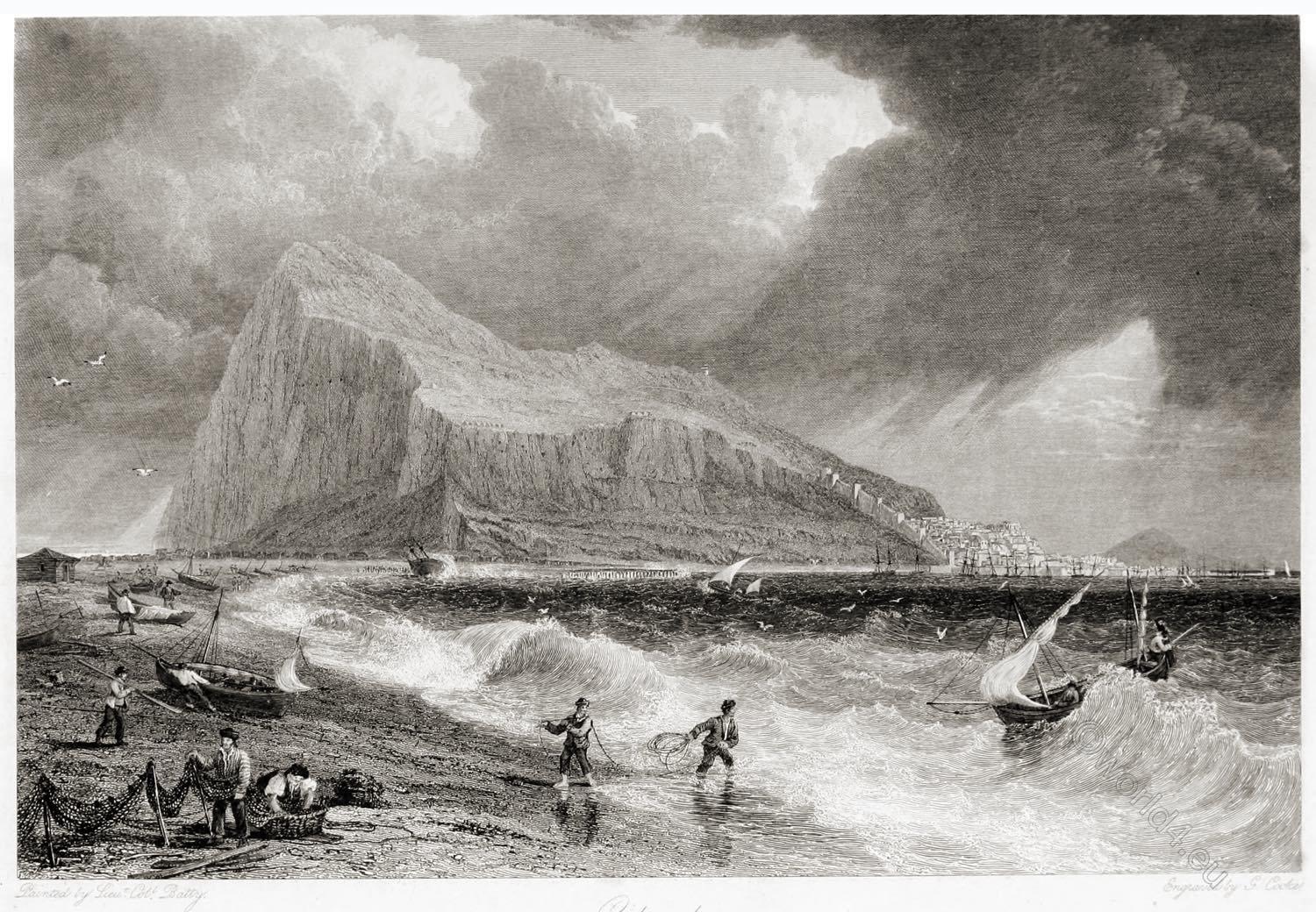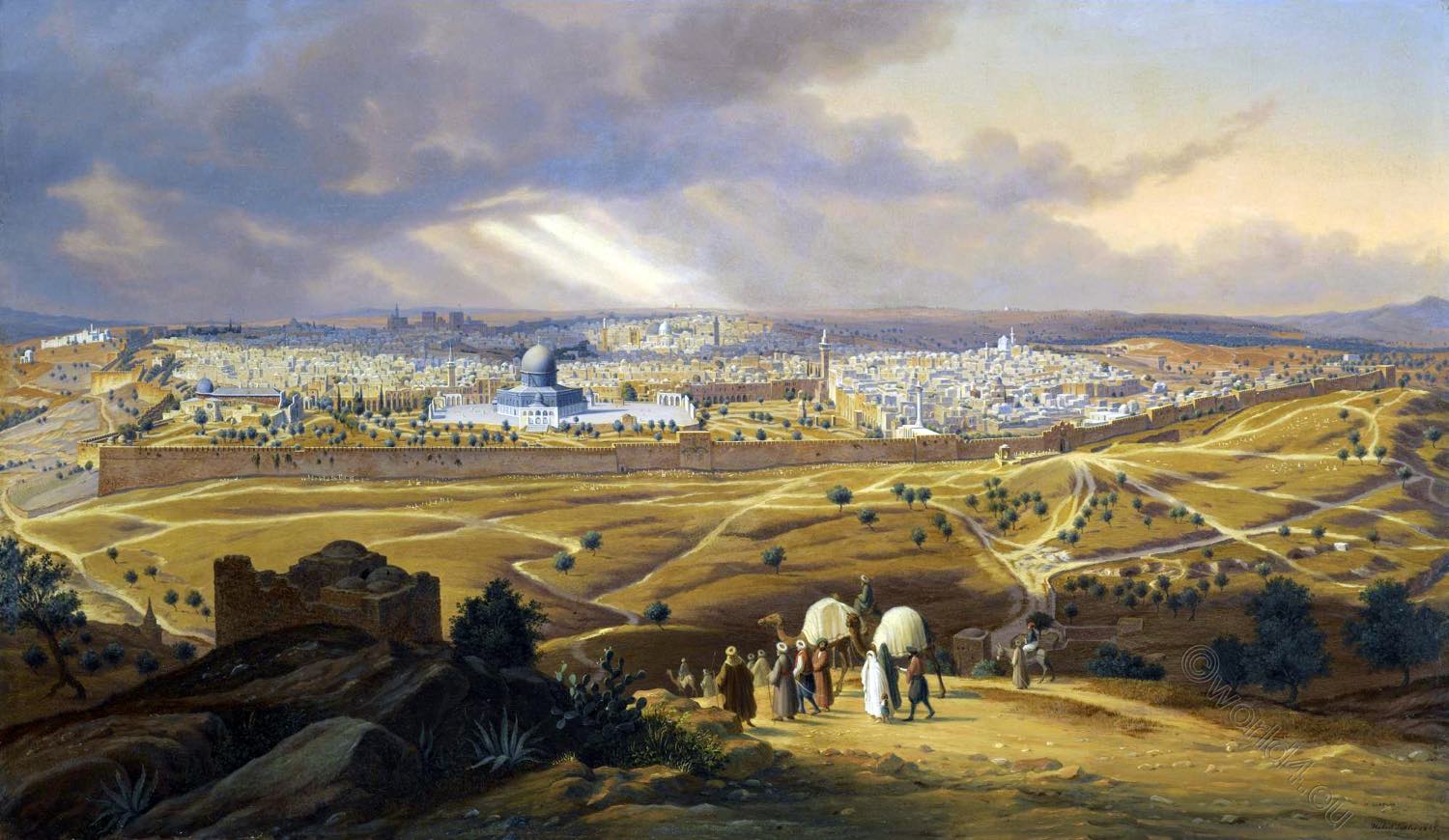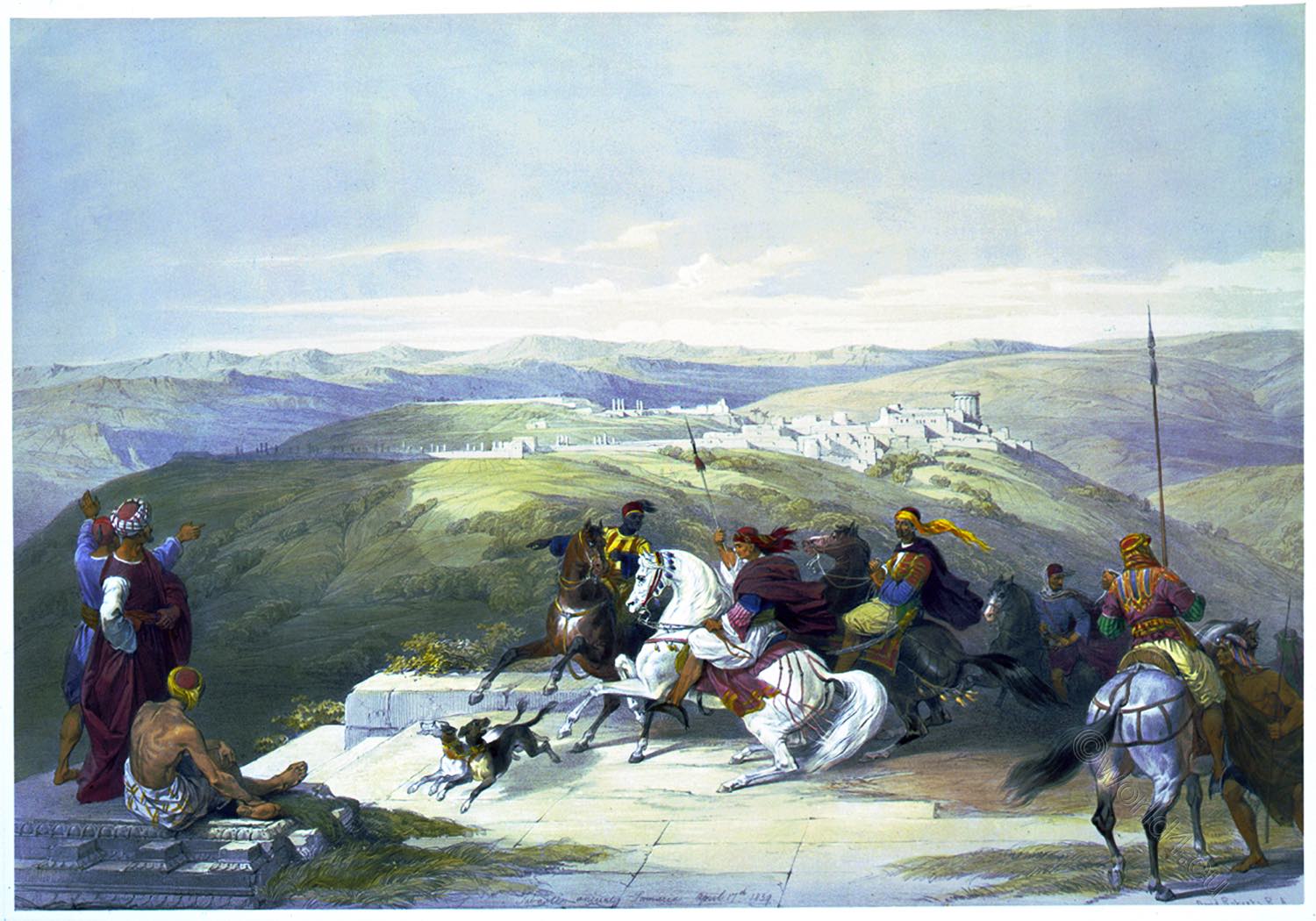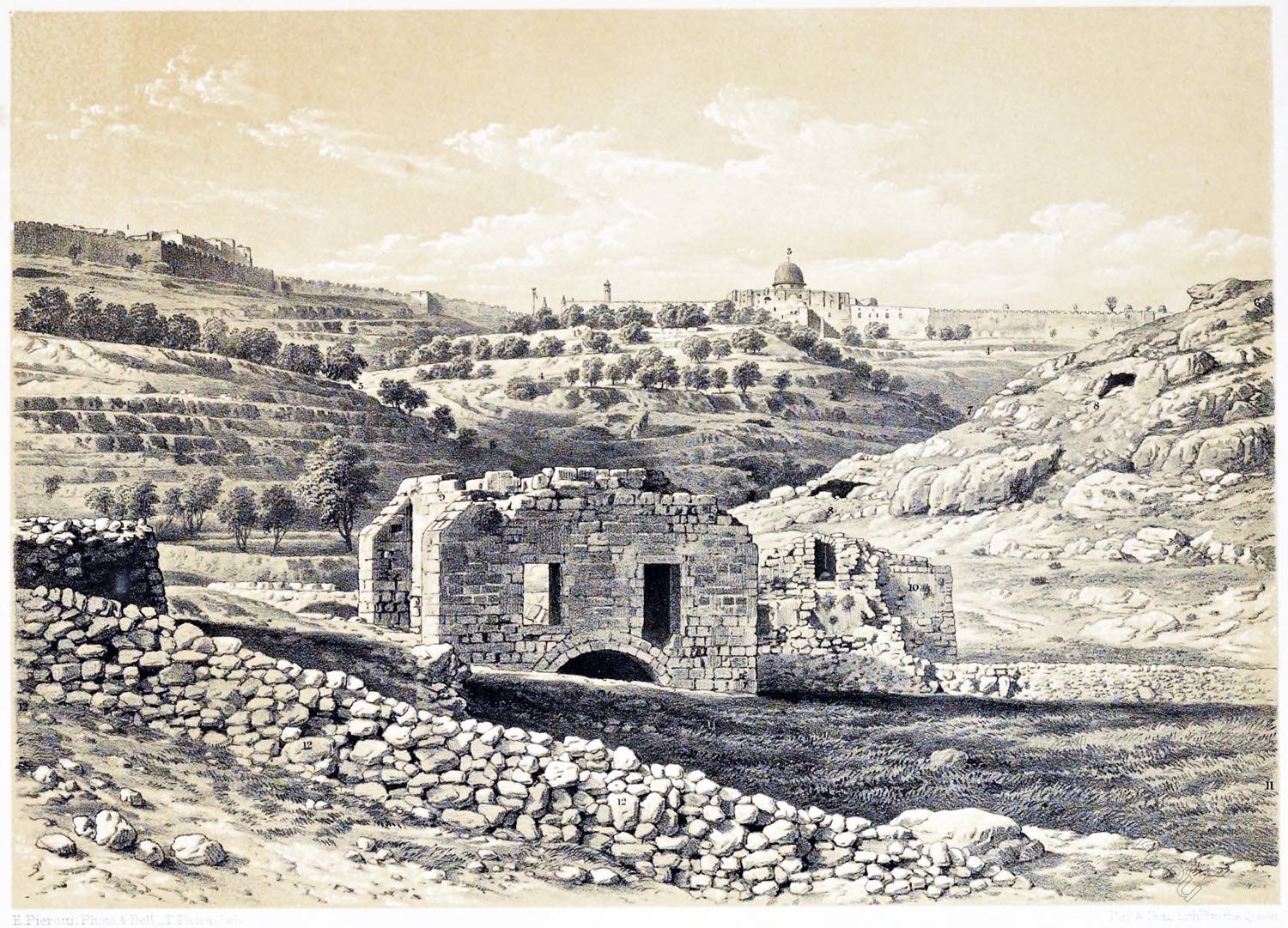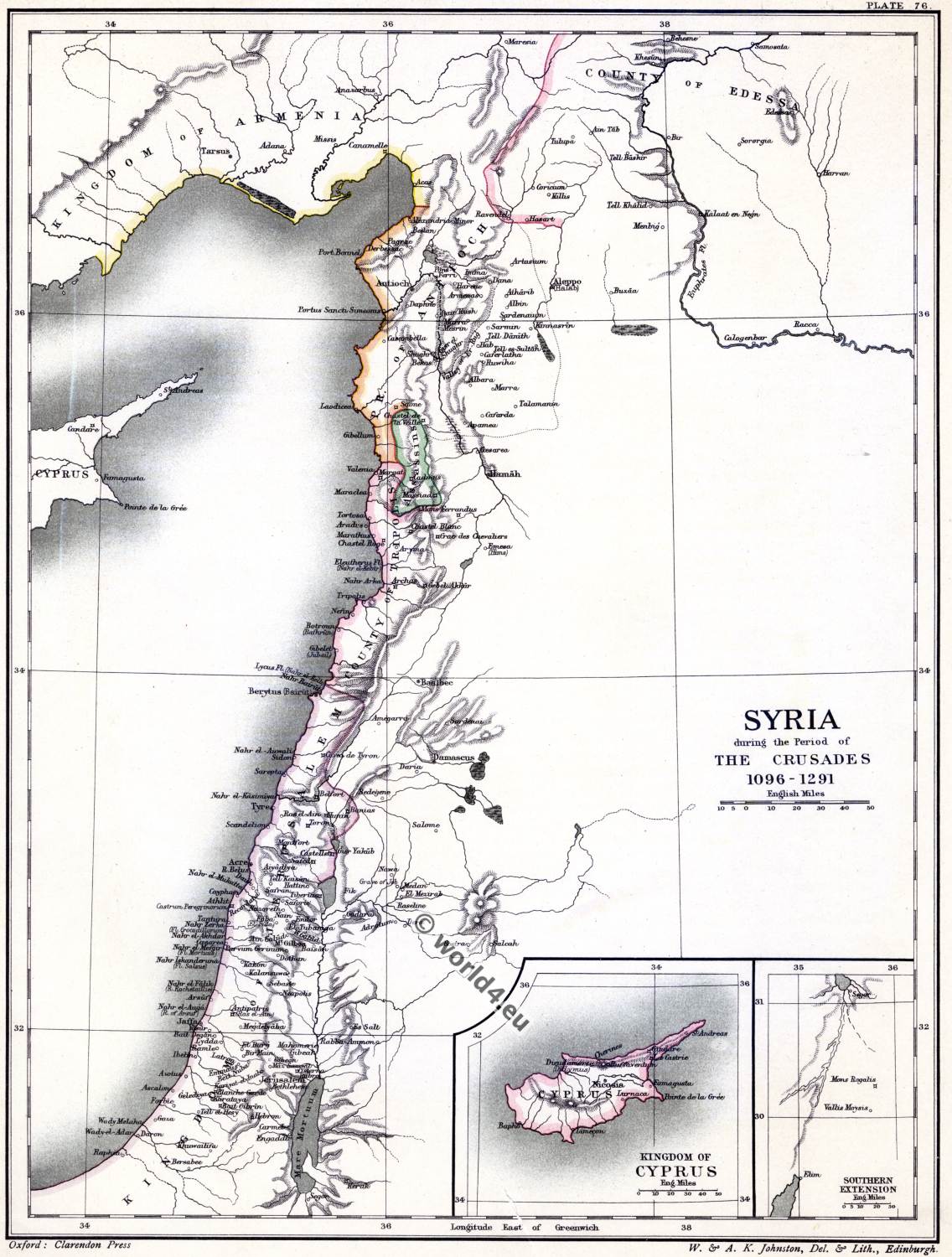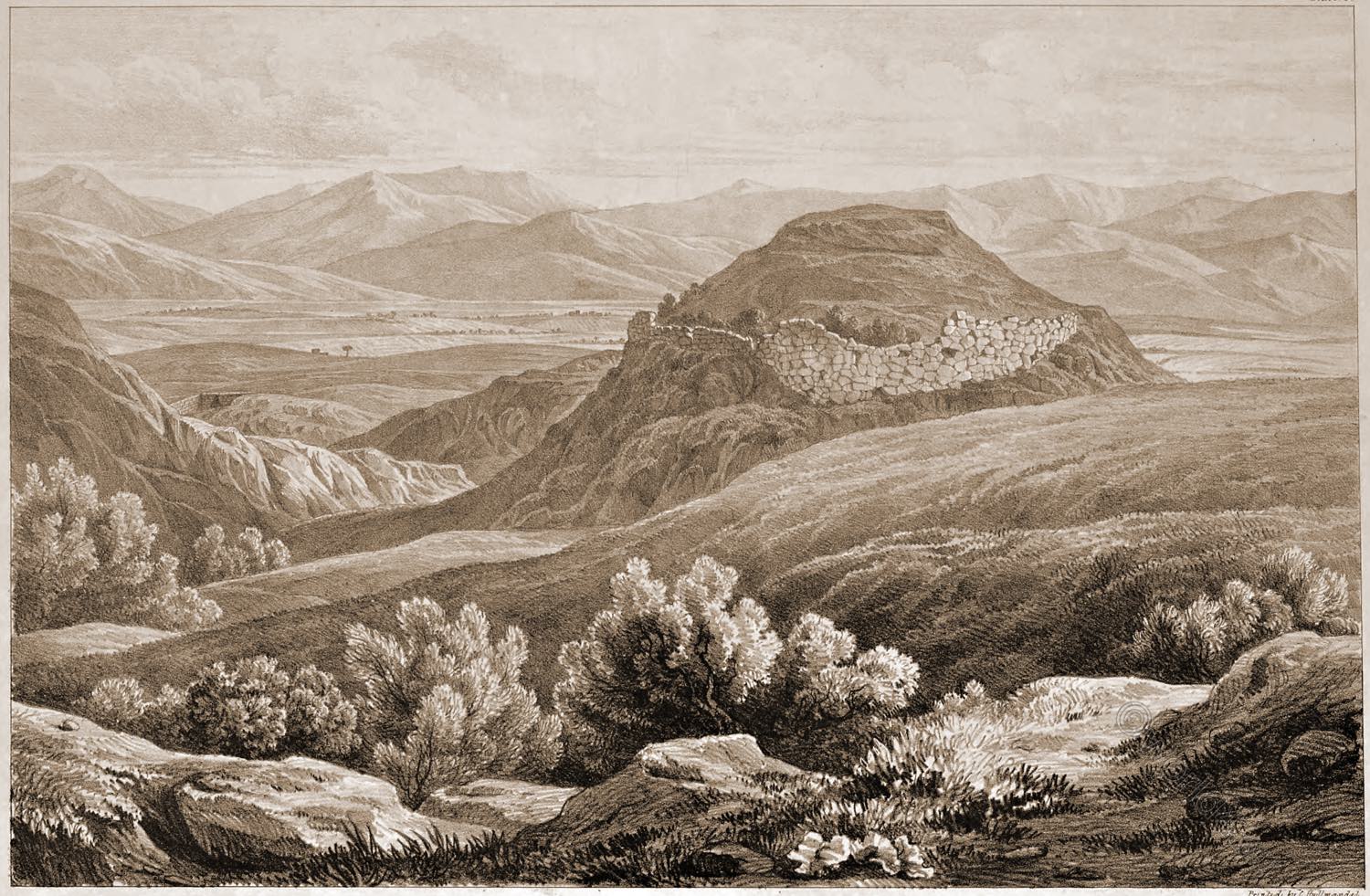ANCIENT JERUSALEM – PHYSICAL AND HISTORICAL.
CHAPTER IX.
THE object of the present study of Jerusalem is not to discuss antiquarian questions, nor any questions, but in a general and broad way to gain such a knowledge of the natural features of the place and of the growth and formation of the city as will enable us to picture to ourselves the scene of our Savior’s passion as it was when He visited and suffered in it, and also as it is in our own time. A well-instructed student of the Scriptures ought to have these things so clearly impressed upon his mind that if he should ever find himself at Jerusalem he would be able, without a guide, to go to any noted historical place of which the situation is certainly known. It has been proved by more than one experience that so much is possible; and although the reader of this book may not accomplish quite so much, he may expect to accomplish the most important parts of it. As our purpose is of this practical sort, we shall spend no time or space on matters of mere conjecture. In cases of doubt, the more probable opinion of the most recent and approved writers will be given, with a mere mention of the fact that other opinions are held.

We shall not then discuss the question of the derivation of the name of Jerusalem, concerning which there is no certainty. Neither shall we inquire whether Jerusalem is the ancient Salem of which Melchizedek was king (Gen. xiv: 18), nor whether that Salem was in the Plain of Jezreel, as St. Jerome declares that it was. Jerusalem evidently cannot be the Salem to which Jacob came, since that Salem was “a city of Shechem.”
The city of the Jebusites.
The place is first mentioned under the name of “the Jebusite,” with the explanation that “the same is Jerusalem” (Josh. xv : 8). In the book of Judges it is called “Jebus”, which is Jerusalem, the city of the Jebusites” (Judg. xix: 10, 11). It was so strongly fortified that, though the Israelites were successful in subduing the Canaanites of other mountain districts, the city of the Jebusites remained unconquered for centuries afterward. Not until the time of David did it fall permanently into the hands of the Israelites. It is true that we read in Judges i : 8 that the Israelites “fought against it, and took it and smote it with the edge of the sword, and set the city on fire;” but this, as Josephus explains, refers only to the lower city of which we shall hear presently, and not to the upper city, which was fortified both by nature and by art.
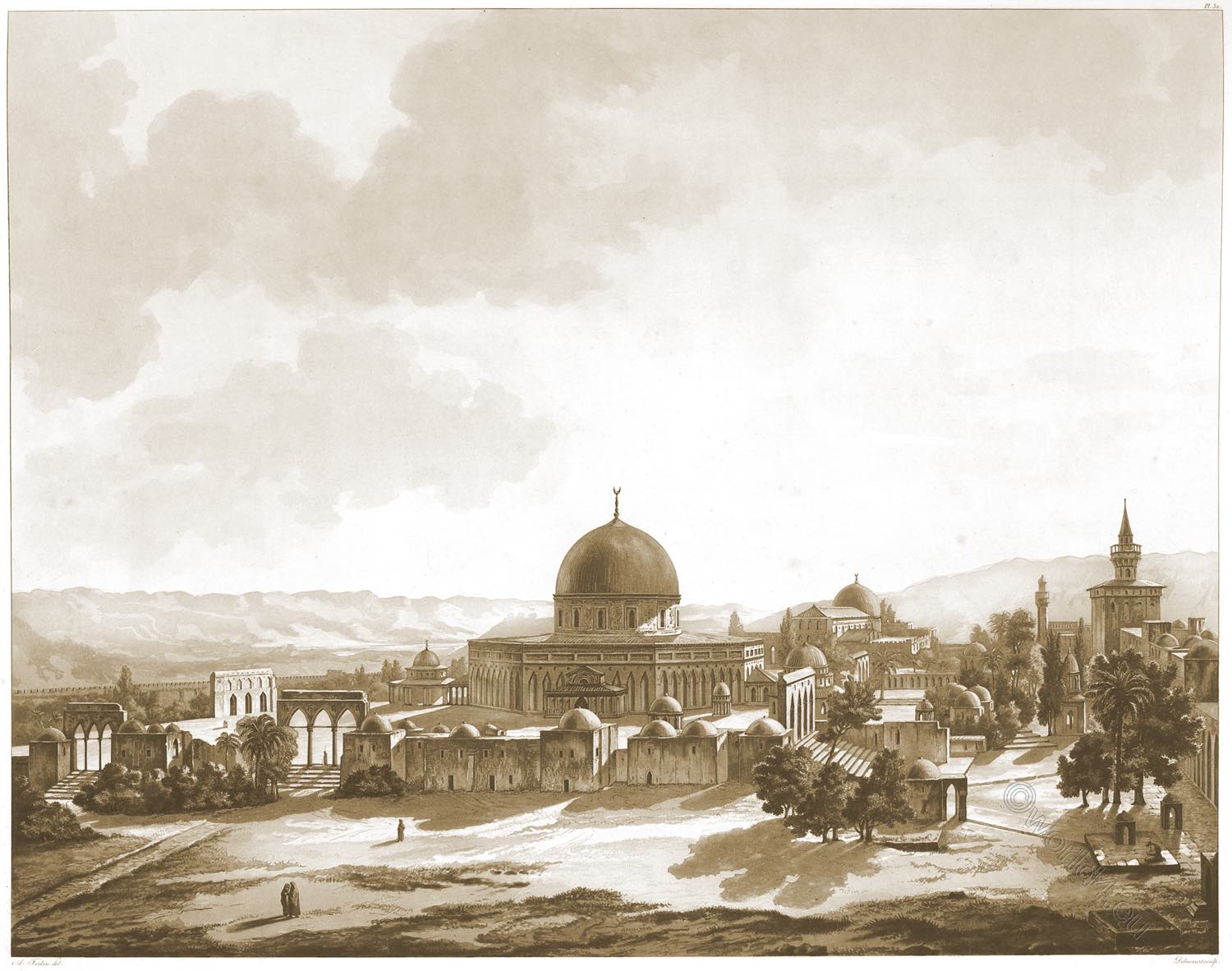
The city of the Jebusites, properly so-called, was not taken at that time; and “when David attempted to besiege it, the inhabitants were so confident of their security that they showed their scorn of the besieging force by manning their battlements with the lame and the blind. Thereupon, as Josephus affirms, David was greatly enraged, and proclaimed to his army that whoever should first scale the heights of the fortress and kill a Jebusite should be captain of the host. The brave men of the army made a simultaneous assault and Joab gained the promised reward. The city was taken and so became the City of David, B. C. 1046.
Jerusalem is situated in the midst of the mountainous table land which extends from the southern boundary of the Plain of Esdraelon (or Jezreel) southward to Hebron, and from the Ghor of the Jordan westward to the lower hills which form the eastern boundary of the Maritime Plain.
Though Jerusalem was not the centre of the land, it was considerably more central than David’s first capital at Hebron, and it lay as far north as he could go without leaving the boundaries of his ancestral tribe of Judah. In addition to this advantage, and the natural strength of its position, Jerusalem lay beyond the usual track of the armies of Assyria and Egypt when these two nations were at war ‘with each other.
We have already seen that when Pharaoh Necho *) invaded Assyria by way of the Plains of Philistia and Sharon he was unable to understand what objection could be made to his line of march by a king ‘who reigned, as Josiah did, at Jerusalem. The natural features of the place, if once fixed in the memory, will make other descriptions easy of comprehension. Therefore those features must be clearly stated.
*) Necho II. (also Nechao, Nekos, Neko, or Nikuu) reigned as the second pharaoh (king) of the Saite dynasty (26th dynasty) from 610 to 595 B.C. He was the son of Psammetich I. An inscription on a serapeum stele shows that the holy Apis bull died in the 16th year of Necho II’s reign on 16 Februarygreg. (6th Pa-en-Ipet) 595 BC and was buried on 21st Aprilgreg.(10th Ka-her-ka).
We have seen that along the north of Jerusalem and at some distance south of Mount Scopus there runs a comparatively shallow valley. At the northeast angle of the city the valley turns to the south and runs along the western foot of the Mount of Olives, close to the east side of the city, rapidly deepening as it goes to the south. This is the Kidron Valley, or the Valley of Jehoshaphat (The word jehoshaphat means ‘God has judged’).

Along the western side of Jerusalem runs another valley of no great depth which is often called the Valley of Gihon. At the southwest of the city this valley turns sharply to the east in front of the Hill of Evil Counsel, deepening as it goes east-ward to join the Valley of Jehoshaphat in the deep gorge which divides the Hill of Evil Counsel from the Mount of Offense (Named from the groves of olive-trees which grew there). This valley, or rather ravine, is the Valley of Hinnom (or Gehinnom in Aramaic, biblical Hebrew “valley of the son of Hinnom“). By the Valleys of Gihon, Hinnom and the Kidron, Jerusalem is enclosed for three-fourths of its circumference.
There is another and lesser but notable ravine which runs from the junction of the Valleys of Jehoshaphat and Hinnom in a direction slightly west of north, so as to separate the southern part of the site of Jerusalem into two hills. This ravine is called the Tyropeon Valley, or the Valley of the Cheesemakers. The hill lying on the ‘west of it is Mount Zion, the original city of the Jebusites, and later the city of David; the other is Mount Moriah, and is believed to be the spot on which Abraham prepared to offer his son Isaac as a sacrifice (Gen. xxii: 2).
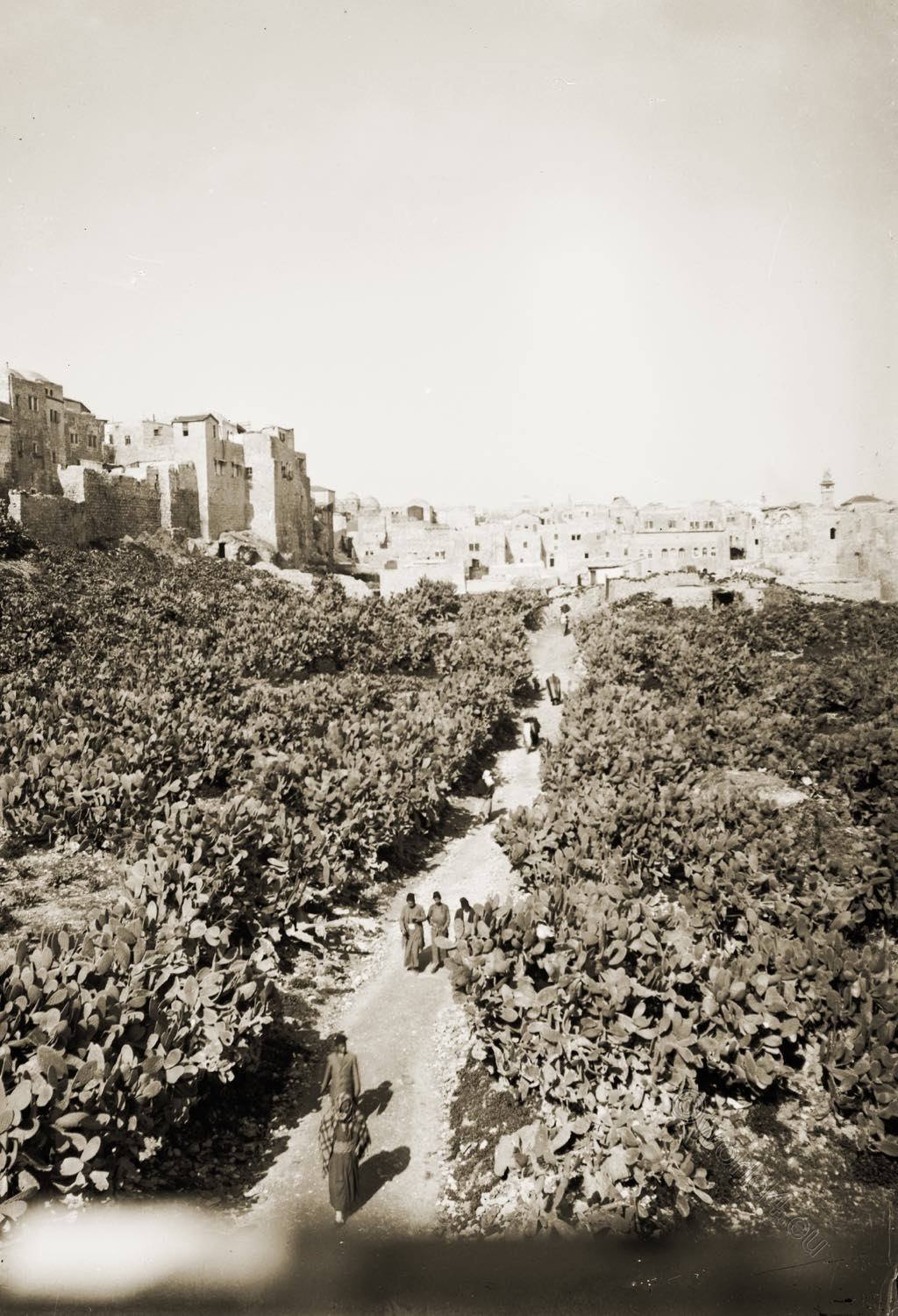
It is important to observe the suddenness of the descent of the two principal ravines. From their several starting-points to their junction on the southeast of the city, a distance of about a mile and a quarter only, there is a fall of more than 600 feet. Thus, to quote from a graphic description, “while on the north there is no material difference between the general level of the country outside the walls and that of the higher parts of the city, on the other three sides so steep is the fall of the ravines, so trench-like their character, and so close do they keep to the promontory at whose feet they run, as to leave on the beholder almost the impression of the ditch at the foot of a fortress rather than of valleys formed by nature.” Between the two spurs which are separated by the Tyropeon Valley the depression is not so great, though it is quite certain that by the accumulation of rubbish and ruins this valley or ravine is now much shallower than it was in ancient times.
Two other depressions which may perhaps originally have been deep enough to be called ravines remain to be mentioned. About midway of the western hill the Tyropeon Valley throws out a subordinate valley westward, thus separating it into two hills; and another similar subordinate valley runs, or certainly did formerly run, east and west on the northern part of the eastern hill.
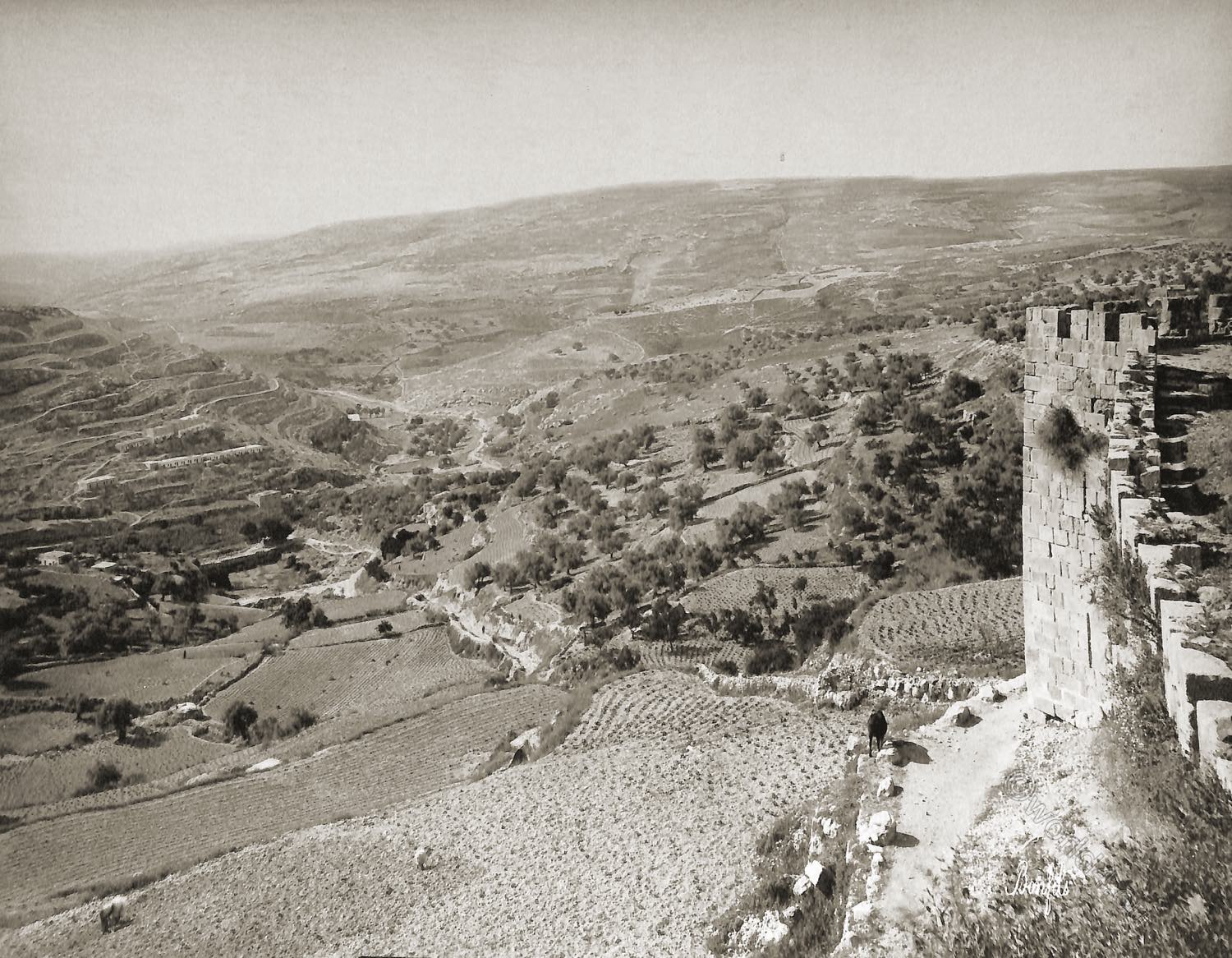
Observing these natural divisions, we are now prepared to distinguish the southern part of the western hill as the Citadel of Zion, also called the Upper City, and the northern part as the Akra, or the Lower City. The central part of the eastern is Mount Moriah, the site of the Temple; the hill on the north of it is Bezetha (Βεζεθά, Caenopolis or the New City); and the southern end of Mount Moriah is called Ophel. Of all these hills, the Citadel of Zion is considerably the highest. Its greatest elevation is 2535 feet above sea level; the highest point of Akra is 2482; of Bezetha, 2487; of the Temple area, 2432; and of Ophel, 2350; so that the general appearance of the surface is that of a slope downward from the southwest hill to Bezetha and Mount Moriah on the north and east, with a steeper slope to Ophel on the southeast. From the summit of Zion to the Pool of Siloam at the feet of Ophel the fall is 410 feet.
To speak of these divisions of Jerusalem in a little more detail, we Inay say of Mount Zion that it is undoubtedly the original city of the Jebusites which became the city of David, and afterward the Upper City or the upper market of Josephus. Here David built his palace, and here for a thousand years not only the kings of Judah, but the foreign rulers who held possession of Jerusalem, resided. Here too was the sepulchre of David and of fourteen of his successors. As Zion was the first, so it was the last part of Jerusalem which owned the rule of Israel. After all the rest had fallen before the battering-rams of Titus-after even the fortress of the temple had been stormed-the last remnant of the Jews, crossing the bridges which then led from the Temple over the Tyropeon Valley to the Upper City, there renewed the conflict in the ancient keep of their kings and perished under the last banner of Israel that was ever raised in Jerusalem.
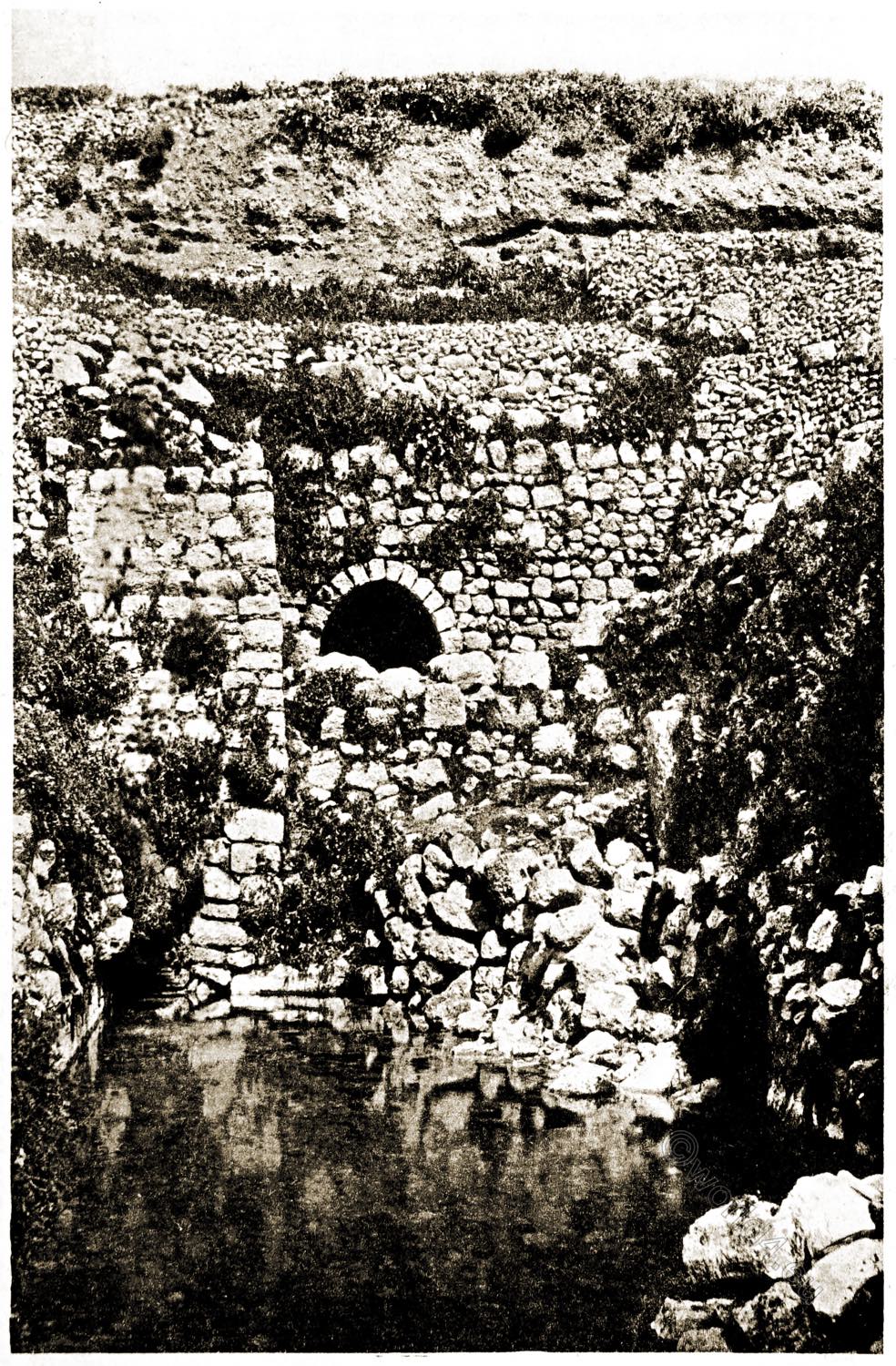
Though we are able to tell with entire satisfaction which of the divisions of Jerusalem is Mount Zion, it is less easy to ascertain its original boundaries, that is to say the lines of its defensive works. Even that however may be done approximately. The City of David included the whole of Mount Zion, and therefore a large part of the hill which lies without the modern wall on the south. The Tyropeon Valley, which has been filled up by the ruins of many devastations to a depth of 120 feet, must then have lain between two inaccessible steeps, and the frowning precipice on its western side was the eastern boundary of David’s city.
On the north the lesser valley thrown out westward from the Tyropeon was of considerable depth, and although it has now become entirely filled up, it was then the northern boundary of Zion. Where that valley once ran is now the Muristan, a wide vacant space within the city beginning not 1110re than 300 paces from the Jaffa gate. In the Middle Ages it was the site of the Hospice of the Knights of St. John and of the Convent of St. Mary. It is now merely an arable field.
Having thus ascertained the limits of the City of David, we can have no doubt of the general position of Akra, or the Lower City. It lay to the north of the branch of the Tyropeon by which it was separated from the Upper City of David. Josephus says that it was separated by a broad valley from the Temple Mount; but that the Asmonean princes leveled the summit of Akra and filled up the intervening valley. The Akra, then, must have included the greater part of the present Christian Quarter lying north of the Jaffa gate, and must almost certainly have included the site of the Church of the Holy Sepulchre. This is the reason why it seems to be impossible to accept the traditional scenes of the death, burial and resurrection of Christ as satisfactory, since it is absolutely certain that they lay without the walls of Jerusalem.
Two names occur in connection with ancient Jerusalem – Millo and Silla. The former is mentioned when David took the city from the Jebusites (2 Sam. v : 9), and it too was one of the great works of Solomon (1 Kings ix : 15). Hezekiah, also, “repaired Millo in the City of David” (2 Chron. xxxii: 5); and in Millo King Joash was murdered (2 Kings xii: 20). Yet we do not know what Millo was. The most satisfactory explanation, in Dr. Tristram’s opinion, is that it was the ancient fortress or keep of Mount Zion, and that the name is a survival of Canaanites times. Of Silla, which is named once in connection with Millo (2 Kings xii: 20), nothing whatever is known.
Several viaducts or bridges spanned the Tyropeon from Zion to Mount Moriah. Remains of two of these, known respectively as Robinson’s Arch and Wilson’s Arch, have been discovered toward the south of the present Haram enclosure. But the present enclosure itself has no such appearance as it had before the time of Solomon. Then it was a distinct and separate hill, with the deep ravine of the Tyropeon dividing it from Mount Zion.
Now it is rather the centre and highest portion of the eastern ridge. Then, too, it had a mound of rock rising in the centre of the ridge ‘with a narrow platforrn on its crest. This was the old threshing-floor of Araunah the Jebusite, which David purchased of him for an altar-place when the pestilence provoked by his sin had been stayed (2 Sam. xxiv: 10-25).
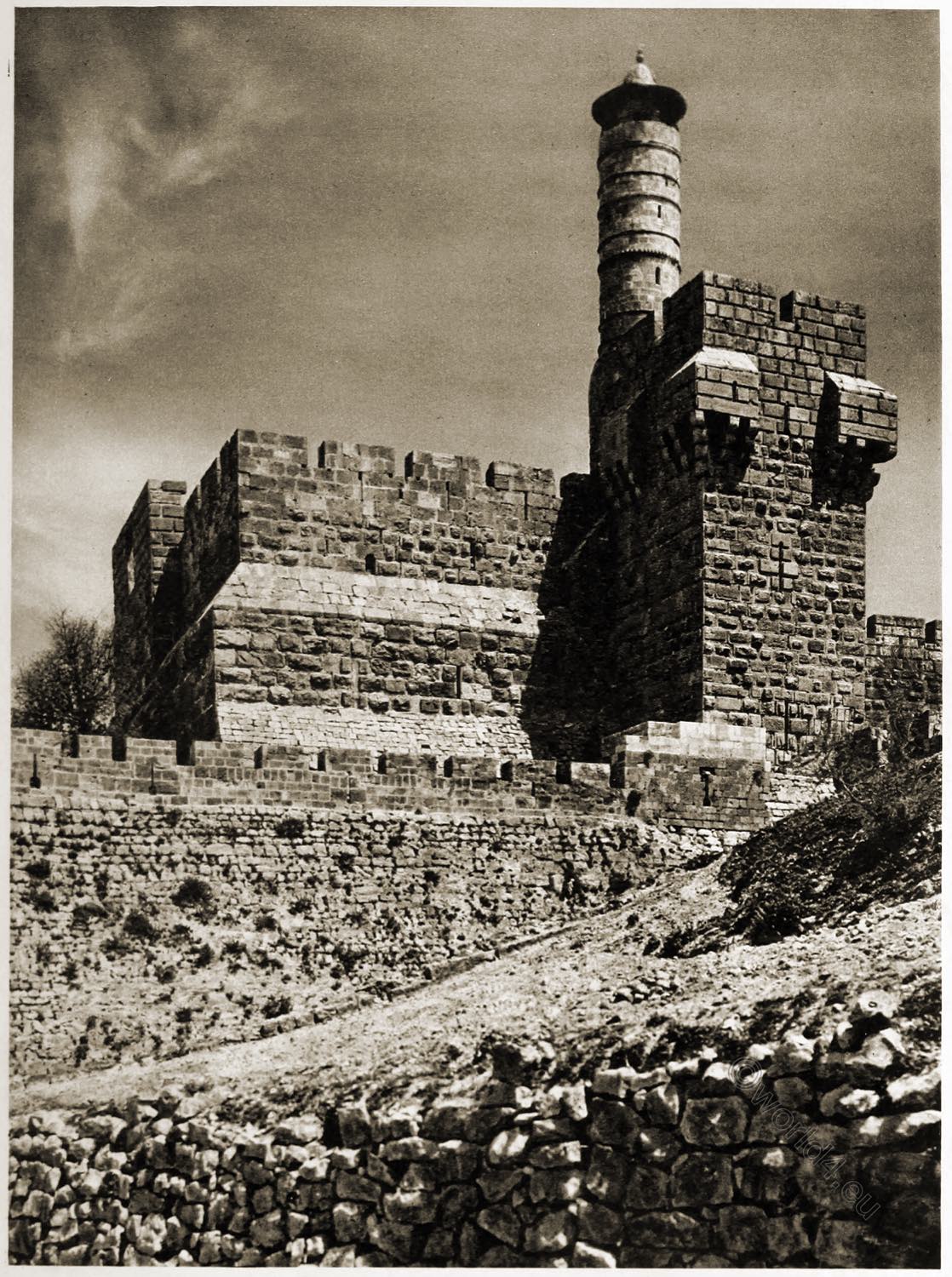
It was around this central rock that Solomon afterward raised a vast platform, supported by massive piers and arches tier above tier and also by walls of stupendous masonry, for the great courts of his magnificent Temple. The interstices were filled in with stones and earth so that the whole platform was made solid, and the substructure was utilized for tanks and reservoirs and drains.
The central rock is now called the Sakhra, and the immense platform wall of the Haram Area, as it is now called, enables us to identify the general positions of the sacred buildings .of Solomon and the extent of Moriah on its northern side. It was separated from Bezetha by a valley now filled up. At the eastern end of this valley, and therefore at the northeast of Moriah, was the deep reservoir called the Pool of Bethesda; and at the northwest angle was the Tower of Antonia, the military key to the Temple fortress.
Mount Moriah is almost beyond question the scene of Abraham’s offering of Isaac, his son; but the immediate cause of the selection of that spot for the site of the Temple was its consecration to the purposes of sacrifice after the staying of the pestilence in the time of David (1 Chron. xxi: 14-27). That the summit of the Mount was then occupied as a threshing-floor proves that it had not yet been included within the city.
The name of Ophel was applied to the low shoulder projecting from Mount Moriah toward the south. It extends to the Pool of Siloam at the junction of the Tyropeon and the Valley of Jehoshaphat, and terminates in a cliff overhanging the pool. The whole of it now lies without the city walls just south of the Haram enclosure, and is terraced for gardens, as the descent southward is very steep. In the time of Solomon, however, or soon afterward, Ophel must have been enclosed within the city, as we read that King Jotham “on the wall of Ophel built much” (2 Chron, xxvii: 3), and between the time of Solomon and Jotham it is not likely that there could have been any great extension of the city.
Afterward Manasseh enlarged the city and “compassed about Ophel, and raised it to a very great height” (2 Chron. xxxiii: 14). Nehemiah also included it in the city as it was rebuilt after the captivity, and assigned it as the residence of the Nethinims or servants of the Temple (Neh. iii: 27). The eastern wall of Ophel has actually been discovered at a depth of seventy feet beneath the present surface, so vast has been the accumulation of rubbish in the many successive destructions of the sacred city. The ancient wall of Ophel is thus ascertained to have been a continuation, but at an oblique angle, of the eastern wall of the Temple platform.
Sir C. Warren, who discovered this wall, suggests that Ophel may have been the site of King Solomon’s palace; but we need not enter into such matters of antiquarian research. The latest addition to Jerusalem, that of Bezetha, is not mentioned in Holy Scripture at all, but it is precisely described by Josephus who says that as the population increased the inhabitants gradually crept beyond the walls, and the quarter north of the Temple was so advanced that it became necessary to take in the fourth hill of Bezetha, that is, New Town. It is separated from the fortress of Antonia, which stood at the northwest angle of the Temple platform, by a deep trench excavated in the solid rock, so as to strengthen Antonia and render it less accessible. It is important to remember that though Bezetha was thickly inhabited it was not surrounded by a wall until eight years after the crucifixion of our Saviour, when Herod Agrippa fortified it and included it within the walls of the city. If it had been a part of the more ancient city the traditional site of the Holy Sepulchre would have been absolutely impossible, as that site lay far within the third ‘wall of Agrippa.
The Temple and the Tabernacle
The importance of Jerusalem to Israel and the world is due less to the fact that it was the seat of Israelitish royalty than to the fact that it became the seat of the chosen Temple of God. Some description of the Temple and of the Tabernacle which preceded it will therefore be in order here.
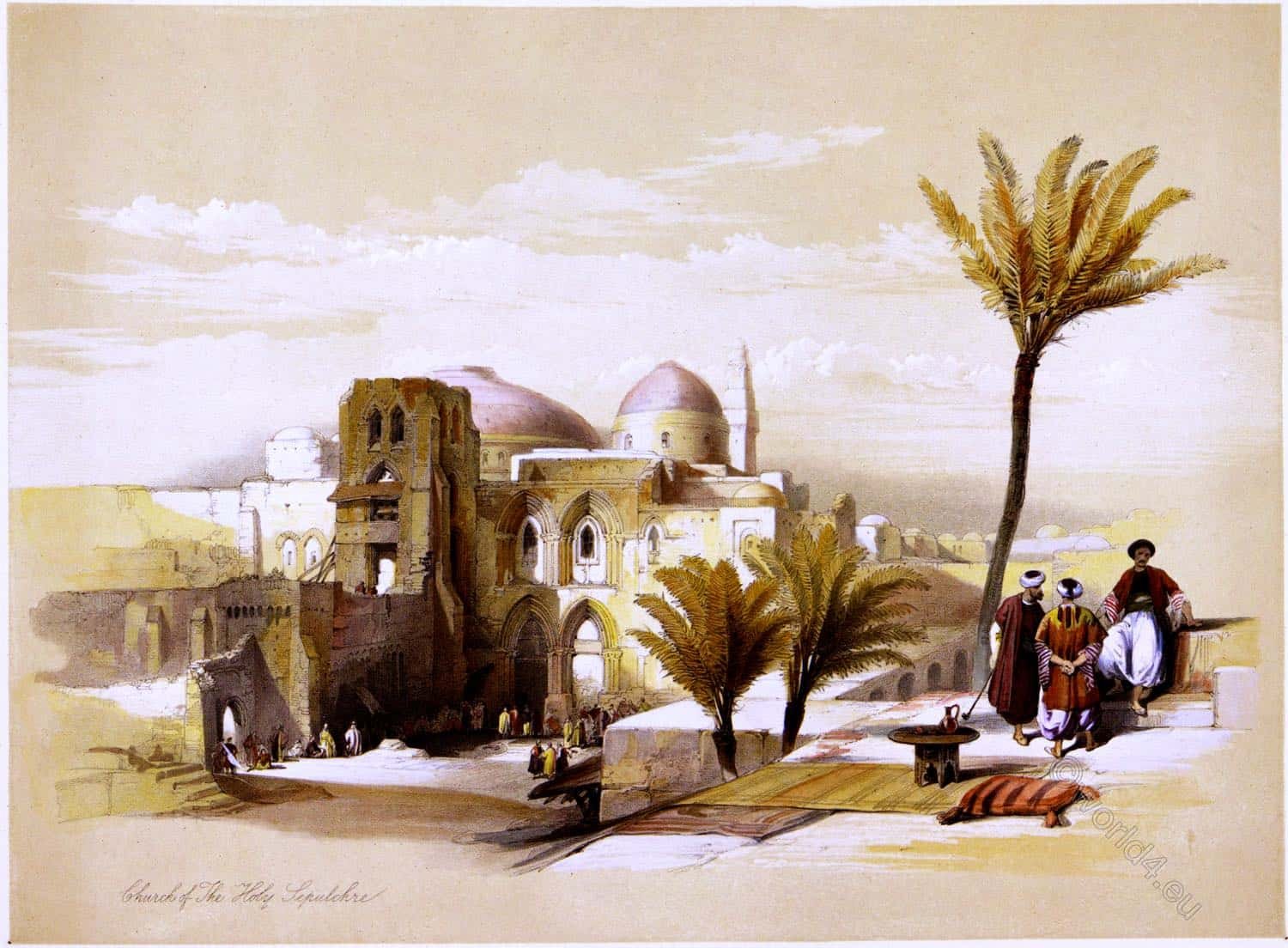
The Temple was intended to replace the Tabernacle which Moses had used in the wilderness; and with all its magnificence its structure and measurements were a close copy of the light and fragile tent which was first devoted to the most sacred mysteries of the Mosaic religion. The Tabernacle was erected by Moses in the desert of Sinai immediately after the promulgation of the law. It stood within an enclosure of curtains forming a double square fifty cubits or seventy-five feet in width by one hundred cubits or one hundred and fifty feet in length. The curtains were five cubits or seven and a half feet high, and were supported by pillars of brass at intervals of five cubits, to which they were attached by hooks of silver. On the eastern end of the enclosure was an entrance twenty cubits wide, which was closed by curtains of fine linen wrought with needlework and of gorgeous colors.
Within this area and toward the west of it stood the Tabernacle. It was a tent thirty cubits long by ten wide according to the account of Josephus, which corresponds with the account of the Bible (Exod. xxvi: 15- 26) if we allow for the width of the corner-posts.
The Holy of Holies was a cubical chamber at the end of the Tabernacle, ten cubits square and ten cubits high. It contained the Mercy Seat, surmounted by the Cherubim, and the Ark of the Covenant in which were the Tables of the Law. Into these chambers not even the priest was allowed to enter except on extraordinary occasions.
In front of the Holy of Holies was an outer chamber called the Holy Place. It was ten cubits long by ten cubits wide and ten cubits high, and was appropriated to the use of the priests. In this outer chamber were placed the Golden Candlestick on one side, on the other the table of Shew Bread, and between them the Altar of Incense. The roof of the Tabernacle was formed of several sets of curtains, for the construction of which exceedingly minute directions were given by Moses (Exod. xxvi).
From Sinai to the Holy Land this Tabernacle was removed by the Israelites as they marched from place to place, and while the Canaanites remained unconquered it continued to be removed as occasion required. Finally it rested at Shiloh, “the place which God had chosen” (Josh. ix : 27; xviii: 1), and there it remained during the whole of the period of the Judges. It was the gathering-point for the heads of the fathers of the tribes (Josh. xix: 51), for councils of peace and war (Josh. xxii: 12; Judg. xxi: 12), and for annual solemn dances in which the women of Shiloh were conspicuous (Judg. xxi: 21).
Then the religion of Israel fell into gradual degradation, and the conduct of the priests was sometimes shamelessly profligate. “The high places” too had a strange attraction for the people, and altars were set up in many parts of the country; but still the Tabernacle held its repute as the House of God and the Temple of God in distinction from all lesser sanctuaries (1 Sam. i : 9, 24; iii: 3, 15).
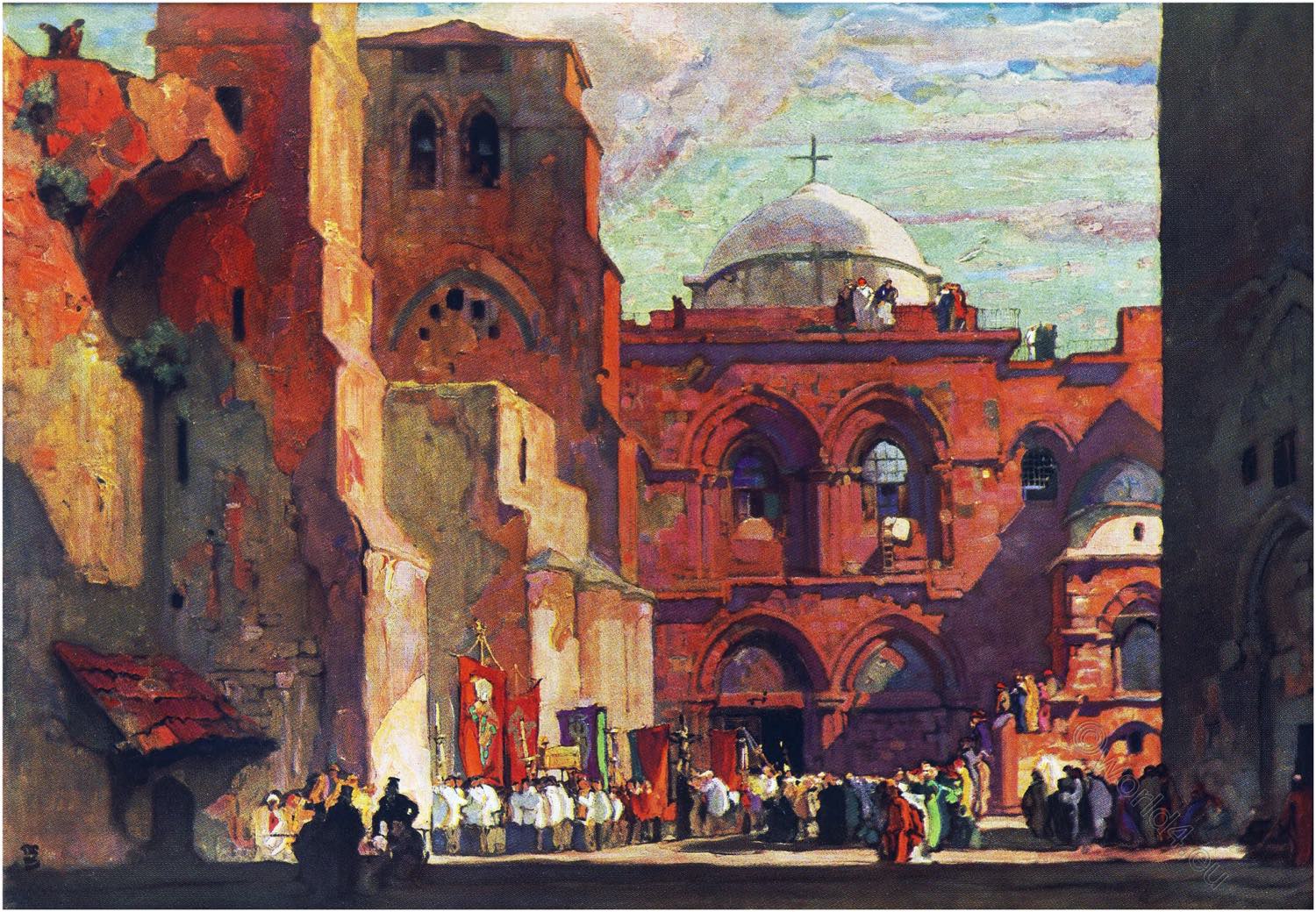
It was perhaps not a misfortune that when the worship of Jehovah was degenerating into a condition little better than the idolatrous worship of the heathen, the Ark of God was taken in battle by the Philistines. It was eventually recovered, but it was not restored to the Tabernacle. For a time it was settled under King Saul at Nob, a city whose site has not been ascertained but which has been plausibly supposed to be the northernmost crest of the ridge of Olivet, north of the Viri Galilaei *) and east of Scopus.
*) The Viri Galilaei Church is a church building in Jerusalem on the northern slope of the Mount of Olives and the seat of the Greek Orthodox Patriarch of Jerusalem.
In some way the Tabernacle came to be set up at Gibeon (1 Chron. xvi: 39 ; 1 Kings iii: 4), and when Jerusalem was captured and a new Tabernacle was erected there containing the Ark of the Covenant (2 Sam. vi : 17) the ancient Tabernacle still continued to be the place of sacrifice, while the new was a place of worship in songs and psalms under the direction of Asaph (1 Chron. xvi: 4, 37, 39 ; xxi : 29). This divided worship continued throughout the reign of David, and the sanctity of both places was acknowledged by Solomon at his accession (1 Kings iii: 15 : 2 Chron, i : 3).
It was the great glory of the reign of Solomon that he was permitted to unite the sanctity and the ceremonies of the two tabernacles in the Temple of Jerusalem. On the summit of Mount Moriah a platform was cleared, and within an area corresponding with the outer court of the Tabernacle a building was erected of proportions closely resembling. those of the Tabernacle, though the dimensions were much greater.
The ground-plan of the Temple measured eighty cubits by forty, and the height was thirty cubits,-not a large building certainly, nor very imposing if this were all that is known about it. But we are told (2 Chron. iii: 4) that the height perhaps only of the porch was one hundred and twenty cubits, or one hundred and eighty feet, which is an enormous height for any building; and such a porch would be out of all proportion to a building of only forty-five feet high.
But we are further told (2 Chron. iii: 9) that Solomon overlaid the upper chambers with gold, and elsewhere we read (2 Kings xxiii : 12) of altars on the top of the upper chambers. It is evident then, that above the lower temple there must have been a superstructure, and both Josephus and the Talmud make the same assertion, adding that the superstructure was of equal height with the lower building. Thus the height of the Temple as seen from without would be not thirty but sixty cubits, or ninety feet. Such an edifice with its facade of one hundred and eighty feet would be a noble and impressive piece of architecture. We need not further detail its special features, since the Temple of Solomon was burned down by the army of Nebuchadnezzar at the time of the captivity (2 Chron. xxxvi: 19).
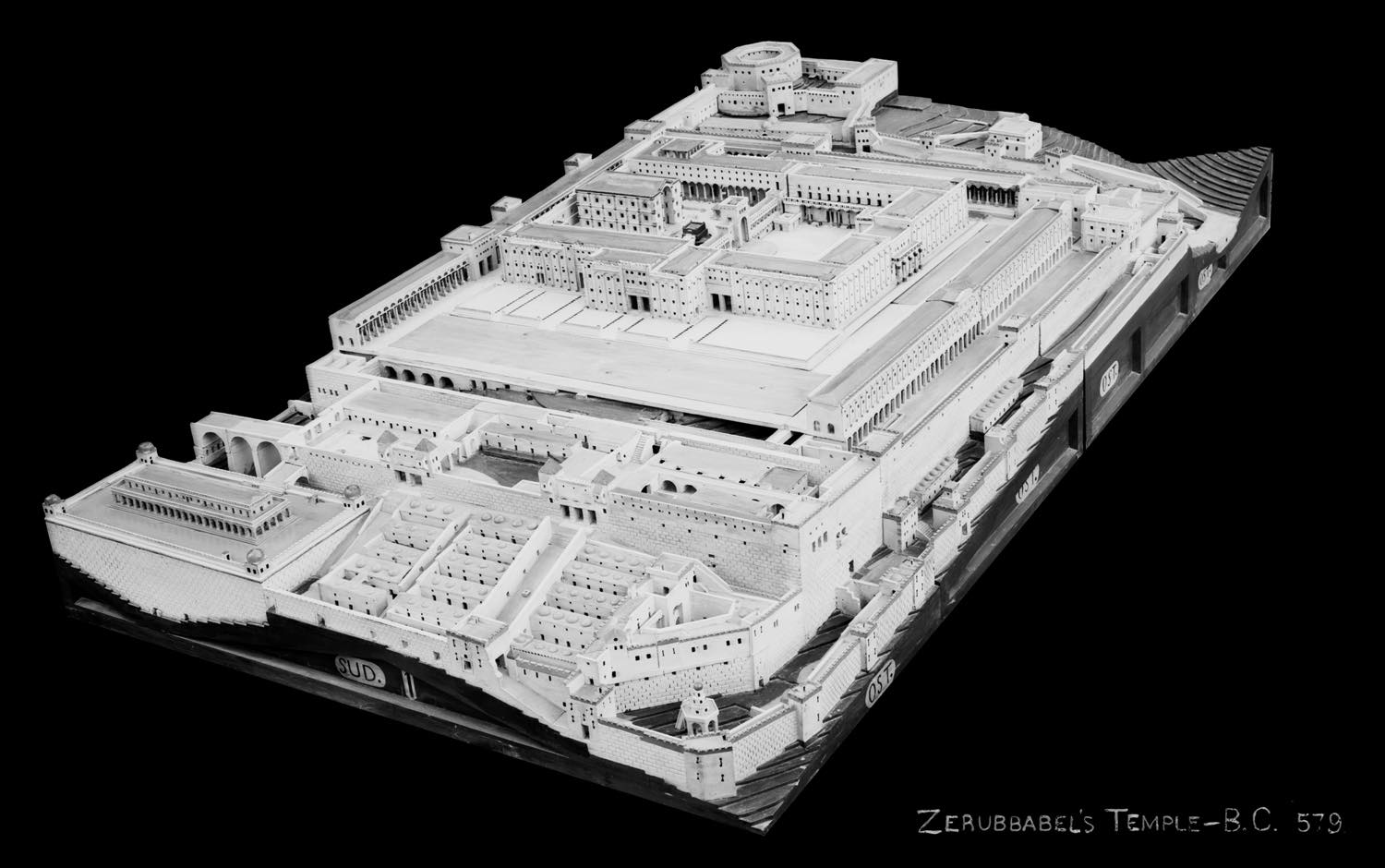
Zerubbabel’s Temple, B.C. 579. The G. Eric and Edith Matson Photograph Collection
The Temple of Zerubbabel, built after the captivity, was probably of the same length as the Temple of Solomon and it was of the same height of sixty cubits, but it ‘was wider by twenty cubits having a width of sixty cubits (Ezra vi : 3). This Temple stood until the time of Herod, and was by him repaired and adorned rather than rebuilt.
Of the Temple of Herod, as it was properly called, we can learn nothing from the New Testament; but the Talmud and the writings of Josephus furnish us with all the information we require. Herod greatly enlarged the area within which the Temple stood, so as to make it a great square of six hundred feet on each side.
The Temple area thus became the principal defense of the city on the east. On that side there were no gates or openings, and being situated on a sort of rocky brow it was at all subsequent times considered impregnable from the eastward. The north side too, besides the fortress of Antonia, became part of the defenses of the city, and was likewise without gates. On the south side, which was enclosed by the wall of Ophel, there were double gates nearly in the centre. On the west there were four gateways. In the time of Solomon, and until the area was enlarged by Herod, the ascent to the Temple from the western valley seems to have been by an external flight of stairs (Neh. xii : 37; 1 Kings x: 5); but when the Temple came to be fortified a bridge and causeway were built over the Tyropeon Valley to connect the Temple area with the upper city of Zion.
The Temple of Herod was similar if not identical in arrangement and dimensions to that of Zerubbabel, but Herod surrounded the Temple area with cloisters or porches which from an architectural point of view were most magnificent. Before his time it is probable that there was a porch called Solomon’s porch on the eastern side, but on the other three sides Herod’s addition was exclusively his own. On the west, north and east sides the cloisters were composed of double rows of Corinthian pillars twenty-five cubits or thirty-seven and a half feet in height, with flat roofs resting against the outer walls of the Temple area.
These cloisters however were greatly inferior to the royal porch which overhung the southern wall. Outwardly, that is to say on the southern side, this magnificent portico was closed by the wall; inwardly, on the side nearest the Temple, it was open. From east to west it extended six hundred feet, in three broad aisles divided by rows of lofty columns, the middle aisle being forty-five feet wide and the other two aisles being thirty feet wide. To the porches surrounding the Temple area Gentiles were admitted, but at a little distance within was a marble fence or screen four or five feet high, beautifully ornamented with carving and bearing inscriptions in Greek and Latin which forbade any Gentile to pass within its boundaries.
A short distance within this screen was a flight of steps leading up to a platform or terrace fifteen cubits above the level of the floor of the southern cloister. Still a little further within, a flight of five or six steps led up to the sacred enclosure of the Temple itself which was called Chel; and the eastern part of this inner enclosure was the Court of the Women, the dimensions of which are variously estimated.
The glory of the inner courts of the Temple was their gateways, and especially the eastern gate of the Court of the Women. It was strongly fortified and richly ornamented with carving and gilding, and had apartments over it, so as to resemble the Gopura of an Indian temple more than any other architectural structure. This was in all probability “The Beautiful Gate” mentioned in the New Testament (Acts iii: 2).
On the west of the Women’s Court and on a still higher level was the Court of Israel, and within that again was the Court of the Priests, surrounded with a portico and having the Great Altar standing in the midst in front of the Temple. Within this last enclosure, west of the Great Altar of Burnt Offering and on a level yet loftier, stood the Temple itself, of the same dimensions as that of Zerubbabel but far more elaborately ornamented. It was fronted on the east by a magnificent facade, behind which was the Holy Place, and at the extreme west was the Holy of Holies.
It seems to be idle to attempt to ascertain with any exactness the details of this wonderful structure; but whatever they may have been, “it may safely be asserted that the triple Temple of Jerusalem-the Lower Court, standing on its magnificent terraces-the Inner Court, standing in the centre of this-and the Temple itself rising out of this group and crowning the whole-must have formed, when combined with the beauty of its situation, one of the most splendid architectural combinations of the ancient world.”
To resume the history of Jerusalem:-
Under Rehoboam, the hot-headed son of Solomon, not only was the kingdom of Israel separated from the kingdom of Judah by a schism which was never healed, but Jerusalem itself was speedily desolated by the hand of a foreign invader. In the year 973 B. C. Shishak, King of Egypt, “came up against Jerusalem, and took away the treasures of the House of the Lord, and the treasures of the King’s House; he took all” (2 Chron. xii: 9).
In the reign of Amaziah, who rashly challenged Jehoash, King of Israel, to battle, a great defeat of the southern kingdom was followed by the surrender of Jerusalem to the victorious Jehoash. The southern wall to the extent of six hundred feet was dismantled in order to keep the city at the mercy of its powerful neighbor, and so Jehoash returned to Samaria with the plunder of Temple and palace, and with hostages from Amaziah (2 Kings xiv: 8-15).
In the reign of Uzziah the fortifications of the city had been restored, and were strengthened by towers (2 Chron. xxvi: 9); Jotham “built much,” as we have already seen, on the wall of Ophel (2 Chron. xxvii: 3); Hezekiah improved the water-supply by aqueducts from the upper pool of Gihon (2 Chron. xxxii: 30); Manasseh immensely increased the circuit of the walls. By these successive improvements Jerusalem was enabled to hold out against Nebuchadhezzar during a siege of eighteen months, at the end of which it was captured and sacked. Most of the inhabitants were put to the sword without distinction of age or sex, and those who escaped from slaughter were carried captives to Babylon. The Temple was plundered and burnt and the wall of the city was broken down (2 Kings xxv; 2 Chron. xxxvi; Jer. xxxix).
The restoration of the Temple by the original command of Cyrus the Great is the subject of the first part of the Book of Ezra. It was begun in 536 B. C., but was almost immediately suspended by order of Artaxerxes on account of the alleged rebellious character of the inhabitants of Jerusalem. At length by a new decree of Darius the work was resumed, and in the year 519 B. C. it was completed, to the great delight of the Jews (Ezra i : 7).
The first six chapters of Nehemiah give an account of the rebuilding of the walls of Jerusalem in troublous times, and of its completion B. C. 445. Thenceforward the Jews were loyal subjects of the Persian monarchs, and an apocryphal story is told to the effect that when Alexander the Great was advancing against the Persians he went to Jerusalem with the intention of capturing it. On his approach, however, Jaddua, who was High Priest at that time, went forth to meet the Macedonian, clad in the vestments of his office and attended by a train of priests and Levites. In Jaddua, the story runs, Alexander recognized a figure which had appeared to him in a dream bidding him go forth and conquer; therefore he at once saluted the High Priest and left the city in peace.
At the distribution of Alexander’s empire among his generals Judah was claimed by Ptolemy, who marched upon Jerusalem, and surprising the garrison by an attack on the Sabbath day captured the city, B. C. 320. As usual, the Temple and the city were plundered, and Ptolemy carried thousands of the inhabitants to his capital of Alexandria, where he granted them many privileges and gave them a rank second only to that of his own Macedonians. In his subsequent wars with Syria Jerusalem was singularly spared, and in 302 B. C. its possession was confirmed to Egypt.
So it remained in peaceful subjection to the Grecian kingdom of the Ptolemaic for one hundred years, and when wars broke out between Syria and Egypt, Jerusalem for a time escaped the horrors of war. In 211 B. C., however, Ptolemy IV Philopator was guilty of a sacrilege which he had cause to repent. He entered the sanctuary of the Temple, but there encountered a vision before which he fled in terror. To his resentment of the fright which he then experienced is attributed his subsequent barbarous treatment of the Jewish inhabitants of Alexandria.
At length the tide of war turned so that Jerusalem. submitted to Antiochus, and for some time the city was treated with clemency and kindness by its Syrian ruler. On the accession of Seleucus to the throne, however, he was disposed to take a harsher course. He sent his treasurer to carry off the sacred vessels and treasures of the Temple; but, like Philopator, the unhappy treasurer encountered a vision in the Temple before which he too fled, leaving his commission unperformed. Under Antiochus Epiphanes a serious attempt was made to turn the Jews from their ancient religion. Menelaus, a semi-pagan priest, was appointed High Priest; but a report of the king’s death reaching Jerusalem in the year 169 B. C., the people rose in mass and drove Menelaus out of the city. This insurrection was severely punished. Two years later Jerusalem was plundered and dismantled, the Temple was again profaned, the sacrifices were discontinued, and the statue of Jupiter Olympus was set up in the Holy Place.
These intolerable enormities were the cause of the heroic struggle of the Maccabees. Gaining victory after victory over the Syrians, they ‘were able in four years, that is in B. C. 163, to restore the Temple; but the citadel of Zion was still held by the enemy, and was not finally surrendered for twenty-one years. The Maccabean princes fortified the Temple with a strength it had never before had, making their own residence in the tower of Baris, which was afterward called Antonia, and which stood at the northwest angle of the Temple area.
For another hundred years Jerusalem remained undisturbed, until dissensions among the Maccabees brought Roman intervention. Then in B. C. 63 Pompey advanced upon it, took it, put 12,000 of the people to the sword in the courts of the Temple, and yet left the sacred vessels and the treasures of the Temple undisturbed. The avaricious Crassus twelve years later was less cruel to the people, but plundered the Temple thoroughly of all its treasures.
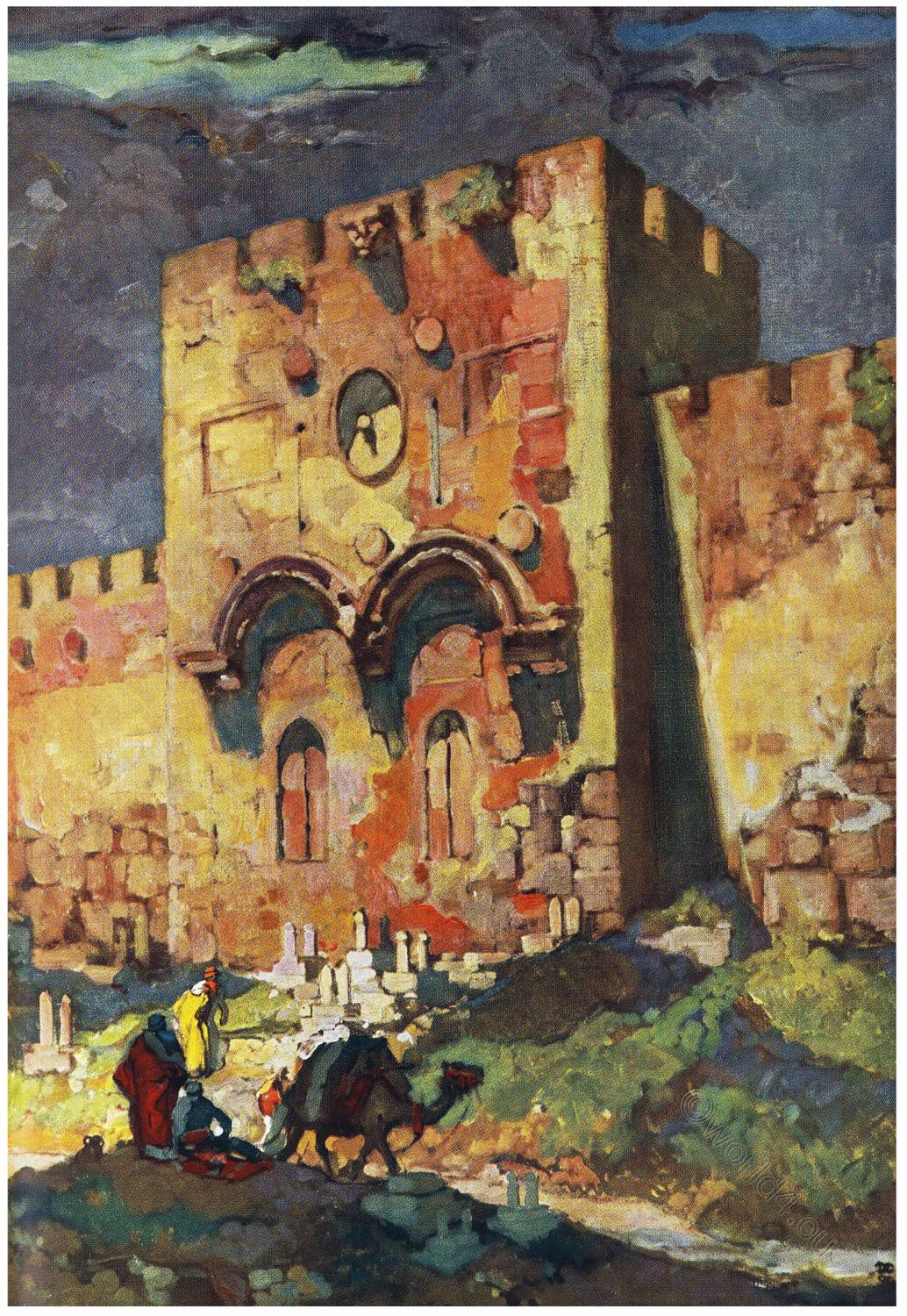
The golden age of Jerusalem
In 43 B. C. began the golden age of Jerusalem as a city of strength and splendor, since in that year began the Herodian improvements under Antipater, father of Herod the Great. But internal discords led to an intervention of the Parthians B. C. 40, and in B. C. 37 Herod with the aid of the Romans captured the city after a gallant defense. The Jews held out to the uttermost, retiring from point to point until the last defenders were subdued in the Tower of Baris. Herod immediately set about a complete refortification and embellishment of Jerusalem. The fortifications were greatly improved; Baris was rebuilt in greater strength than before and was called Antonia; on the west of the city, south of the present Jaffa Gate, was built the citadel with its three Towers of Hippicus, Phasaelus and Mariamne, of which (probably) the first remains under the name of the Tower of David. Herod erected a town hall, and also, according to custom, a theatre. Near the citadel he had his own palace and his gardens. Needless to say that his greatest work of all was the restoration of the Temple, as already described. Pliny writes of Jerusalem at that time that it was “by far the most magnificent of the cities of the Orient, and not merely of Judea.”
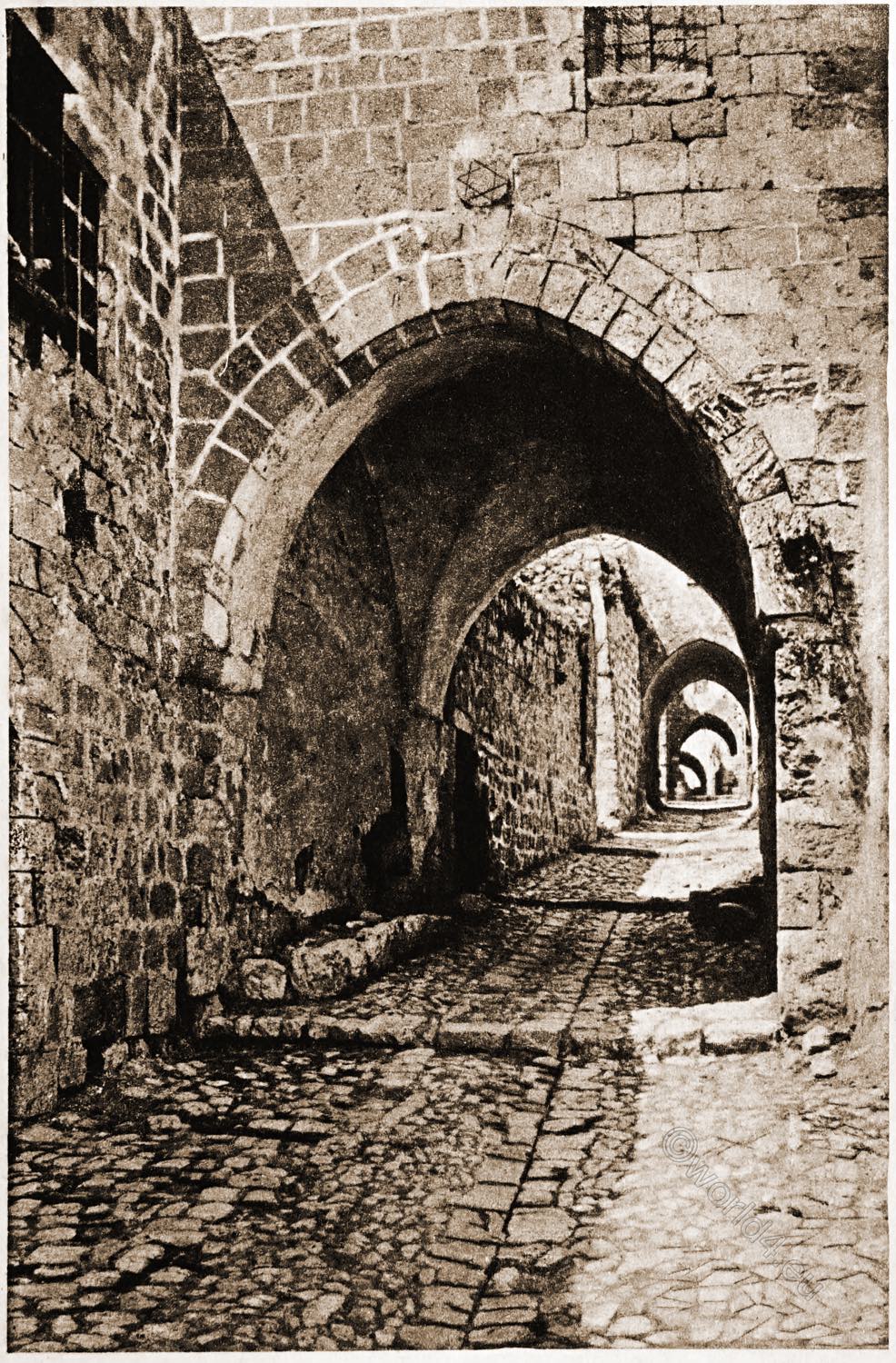
After the death of Christ, Agrippa I. erected a wall, commonly called the Third Wall, which enclosed the whole of the northern suburb of Bezetha within the city. This wall is said to have been extremely strong, being built of huge stones and being defended by no less than ninety towers. The strongest of these was Psephinus at the northwest angle, which is said to have been one hundred feet in height. Agrippa did not complete his wall, for fear of incurring the displeasure of the Emperor Claudius; but it was afterwards finished by the Jews in a less substantial manner than that in which it had been begun. Its very course is now unknown. The time of ruin which Jesus foretold came on in A. D. 70, when Jerusalem was once again “compassed about with armies,” and after a siege by Titus, the horrors of which have never been surpassed, it was utterly destroyed.
The following brief but excellent account of events which led up to the siege of Jerusalem is taken from Baedeker: “Ever since the land had become a Roman province a storm had begun to brood in the political atmosphere, for the Jews were quite as much swayed by national pride as the Romans. The country was moreover disquieted by roving marauders (sicarii), and several of the Roman governors were guilty of grave acts of oppression, as for instance Gessius Florus, who appropriated the treasures of the Temple.
At this time there were two antagonistic parties at Jerusalem; the fanatical Zealots under Eleazer, who advocated revolt against the Romans, and a more moderate party under the High Priest Ananias. Florus in his undiscriminating rage having caused many unoffending Jews to be put to death, a fearful insurrection broke out in the city. Herod Agrippa II. and his sister Berenice endeavored to pacify the insurgents and to act as mediators, but were obliged to seek refuge in flight. The Zealots had already gained possession of the Temple precincts, and the Castle of Antonia was now also occupied by them.
A wild struggle now ensued between the two Jewish parties, and the stronger faction of the Zealots succeeded in wresting the upper part of the city from their opponents, and even in capturing the Castle of Herod, which was garrisoned by 3000 men. The victors treated the captured Romans and their own countrymen with equal barbarity. Cestius Gallus, an incompetent general, now besieged the city, but when he had almost achieved success he gave up the siege and withdrew toward the north, to Gibeon. His camp was then attacked by the Jews and his army dispersed. This victory so elated the Jews that they imagined they could now entirely shake off the Roman yoke. The newly constituted council of Jerusalem, composed of Zealots, accordingly proceeded to organize an insurrection throughout the whole of Palestine.
The Romans, however, now fully alive to the seriousness of the danger, despatched their able general Vespasian with 60,000 men to Palestine. This army first quelled the insurrection in Galilee (A. D. 67). Meanwhile the conflicts within Jerusalem itself continued. Bands of robbers took possession of the Temple, and when besieged by Ananias summoned to their aid the Idumeans (Edomites), the ancient hereditary enemies of the Jews. To these auxiliaries the gates were thrown open, and with their aid the moderate party, with Ananias its leader, was annihilated. The adherents of that party were proscribed, and no fewer than 12,000 persons of noble family are said to have perished on this occasion. The Zealots committed frightful excesses, and made common cause with the robbers, while the Idumeans, having sated themselves with plunder, quitted Jerusalem.”
It was not until Vespasian had conquered a good part of Palestine that he advanced upon Jerusalem; but events at Rome compelled him to entrust the continuation of the campaign to his son Titus. When the latter approached Jerusalem there were no fewer than four hostile parties within its walls. The Zealots under John of Giscala occupied the Castle of Antonia and the Court of the Gentiles, while the robber party under Simon of Gerasa held the upper part of the city; Eleazer’s party were in possession of the Court of Israel and the inner Temple; and lastly, the moderate party, which had again risen, was also established in the upper part of the city. Titus marched from Egypt with two legions, each of about 6000 men; three legions were already on the spot; and to these he added another legion and numerous auxiliaries.
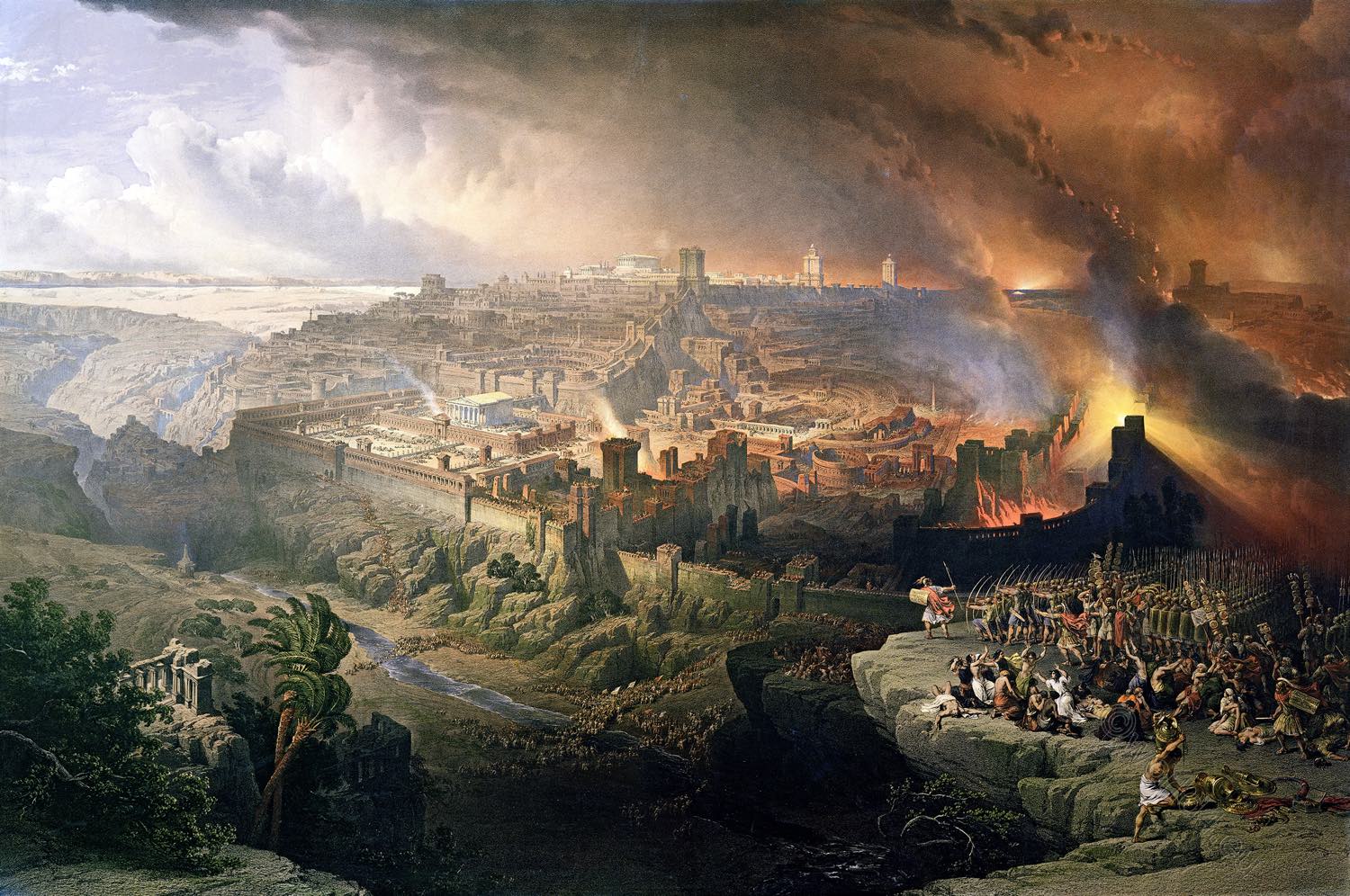
Thus, at the beginning of April, A. D. 70, six legions were assembled in the environs of Jerusalem. While reconnoitering the position of the place Titus narrowly escaped being cut off from his army. He then posted the main body of his forces to the north and northwest of the city, while one legion occupied the Mount of Olives. The Jews attempted a sally against the latter but were driven back by Titus, who hastened to its aid. In the course of the conflicts which still continued within the city John of Giscala succeeded in driving Eleazer from the inner precincts of the Temple, but he was still opposed by the robber party under Simon. On April 23d the besieging engines were brought up by the Romans to the west wall of the new town (perhaps near the present Jaffa Gate). The Jews defended themselves bravely, but on the 7th of May the Romans effected an entrance into the new town.
Five days later Titus endeavored to storm the second wall but was repulsed. Three days afterward he succeeded in taking it, and then he caused the whole north side of the wall to be demolished. He then sent Josephus, who was in his camp, to summon the Jews to surrender, but in vain. A famine soon set in, and those of the besieged who endeavored to escape from it and from the barbarities of Simon were crucified by the Romans. The besiegers next began to erect walls of attack, but the Jews partially succeeded in destroying them. Titus then caused the city wall, which was thirty-three stadia in length, to be surrounded by a wall of thirty-nine stadia in length. Thus the city was completely surrounded; the severity of the famine was greatly aggravated; many perished and the bodies of the dead were thrown over the wall by the besieged.
Again the battering rams were brought into requisition, and at length, on the night of July 5th, the wall was stormed. A fierce contest took place around the gates of the Temple, which the Jews continued to hold with the utmost tenacity. By degrees the colonnades of the Temple were burned down; yet every foot was stubbornly contested. At last on the 10th of August a Roman soldier, contrary it is said to the command of Titus, cast a firebrand into the Temple; the sacred edifice was burned to the ground, and those who escaped the flames were cut down by the swords of the Romans. A body of Zealots however contrived to force their way to the upper part of the city. While the lower part of the city was actually in flames negotiations were again opened for a surrender, but in vain.
The upper part resisted stubbornly, and it was not until the 7th of September that it too “was burned down. Jerusalem was now a heap of ruins. Those of the surviving citizens who had fought against the Romans “were put to death, the rest were sold as slaves. On his return to Rome Titus celebrated a magnificent triumph together with his father Vespasian, and John of Giscala was led as captive in the triumphal show. The noble arch of Titus at Rome was erected to commemorate this victory, which forever destroyed the political importance of Jerusalem.
Thus the City of David and Solomon and Hezekiah and Herod was reduced to utter ruin. The inhabitants were literally extirpated. The whole wall, except on the western side, was demolished. Only three of all the towers were left standing. To prevent the reoccupation of the place by Jews, Csesar’s famous Tenth Legion was left as a garrison over the ruins. So it remained, peaceful with the peace of the desert, until A. D. 131 when Hadrian ordered it to be rebuilt.
Simultaneously occurred the great rebellion of the pretended Messiah, Bar-Cochebas, which was utterly suppressed in 135. From that year some historians have thought we ought to date the final dispersion of the Jews from their own land, so ruthlessly unsparing was the hand which drove them out. In Jerusalem a Roman colony was established, and within its limits no Jew was allowed to enter. On Mount Moriah a Temple to Jupiter Capitolinus was erected, and the new city was called Aelia Capitolina, a name which it continued to bear for centuries. It was so called by a Christian Council held in 536, and so even Mohammedans called it until after the Crusades, when they gave it the name of El Khuds, or the Holy.
In less than two hundreds years from the foundation of the new city of Aelia Capitolina on the site of ancient Jerusalem the Roman Empire had become Christian, and in 326 the Empress Helena, mother of Constantine, visited in her eightieth year the holy places of the Christian religion. So extensive were her works of piety in the building of churches and convents, that when the origin of any building that can be at all referred to that time is unknown the monkish historians invariably fall back upon the Empress Helena as its foundress.
Nine years after the visit of Helena the Emperor Constantine founded the Church of the Holy Sepulchre on the site of a Temple of Venus which tradition pointed out as the place of Christ’s burial. There too was discovered the True Cross. Three crosses were said to have been found at the same spot, two of which were at once understood to be those of the thieves who were crucified with our Lord. To distinguish the True Cross of Christ from the crosses of the thieves was perfectly simple.
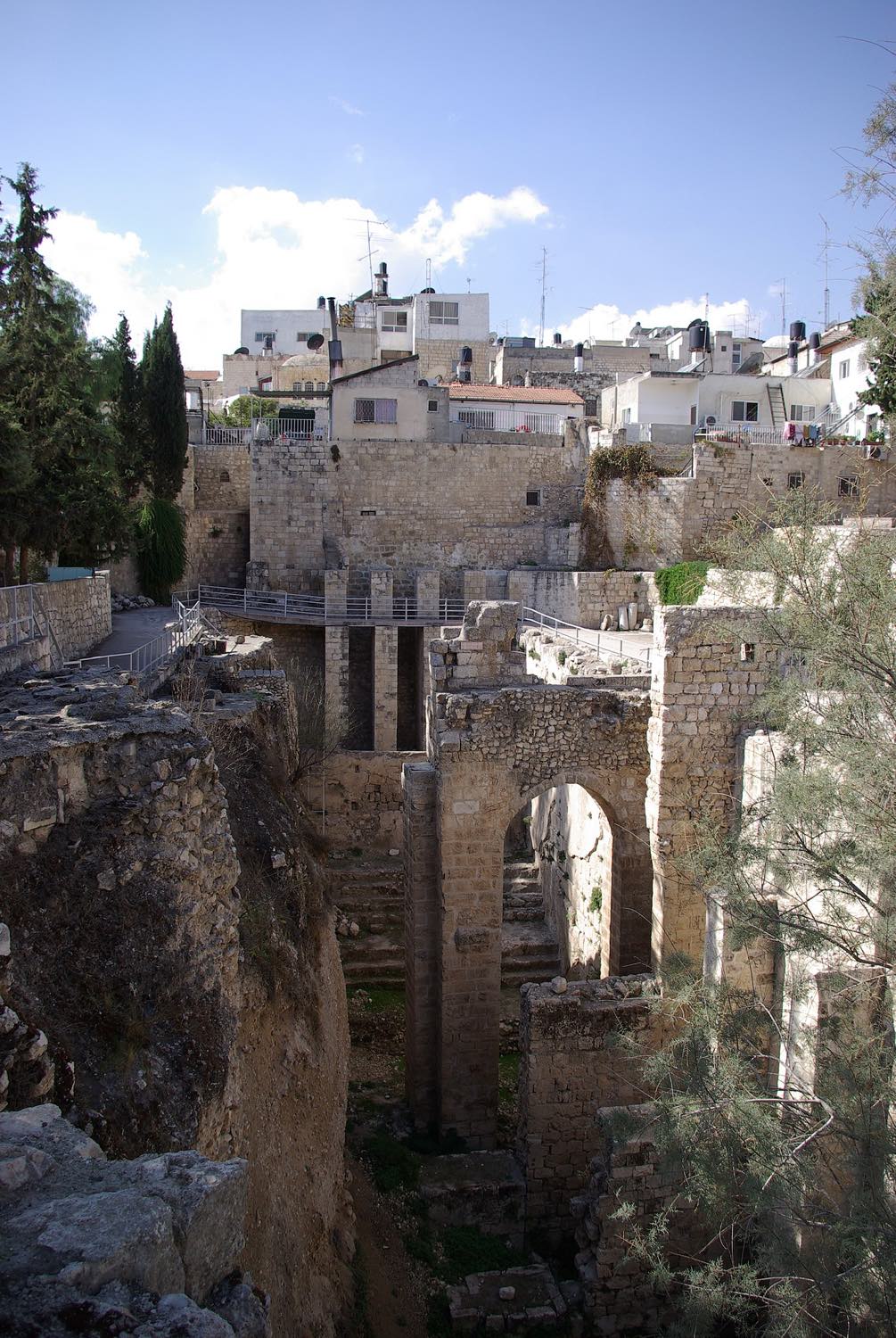
A number of sick people were brought to the place and made to touch the three crosses successively; in every instance it was found that when they touched two.of the three crosses they remained unrelieved, but that when they touched the third they were forthwith healed of whatsoever disease they had. The conclusion was irresistible that the healing cross was indeed the Cross of Christ. Naturally many persons wished to have a fragment of the wood of the True Cross, and the wish was granted to such an extent that the wood thus given away must have been many times as great as the original quantity contained in the cross itself. This, however, was easily explained by the Patriarch of Jerusalem, who affirmed that the wood of the True Cross was like that of the burning bush, and was not at all diminished by the fragments which were taken from it. Like the widow’s barrel of meal it was not wasted, but day by day ‘was found to be of the same proportions as it was when first it was discovered.

Image source: The Christian in Palestine; or, Scenes of sacred history, historical and descriptive by Henry Stebbing (1799-1883). London: G. Virtue 1847
The apostate Emperor Julian repealed the law which prohibited the Jews from entering Jerusalem, and rather to spite the Christians than to gratify the Jews, he gave orders for the Temple to be rebuilt. The work was accordingly begun, but by the death of Julian in 362 it came to an abrupt conclusion and again the Jews were excluded from the city of their fathers. Throughout the fifth century and for centuries afterward Jerusalem was thronged by a never-ceasing stream of pilgrims from all parts of the Christian world, and the Bishop of Jerusalem, or rather of Aelia Capitolina for so he was called, was promoted to the ecclesiastical rank of a Patriarch of equal degree with the Patriarchs of Rome, Constantinople and Antioch. In 527 Justinian built a magnificent Church of the Virgin on Mount Moriah, and many convents and hospices for the entertainment of pilgrims to the Holy City.
In 614 a great disaster befell. The Persians defeated the forces of the Emperor Heraclius and took possession of Jerusalem. There was a merciless slaughter of the inhabitants, and the Patriarch of Jerusalem, together with the notables of the city and the True Cross, were carried off. The next year however peace was made by the contending parties; the prisoners were released, and the Emperor Heraclius himself insisted on bearing back the Cross on his own shoulders to the place whence it had been taken.
In 636 the Khalif Omar attacked Jerusalem, and after a stubborn resistance it surrendered in the following year. The cross fell before the crescent, and the beautiful Church of Justinian was converted into the Mosque of Omar which still crowns the Holy Mount of Moriah. During the following centuries the Christian pilgrims who thronged the Holy Places, which were now in possession of the infidels, were subjected to continual insults and to the degrading payment of a poll-tax of so much per head. The indignation throughout all Christendom smoldered for ages until the time came for it to break out in the romantic episode of the Crusades. In 960 the sovereignty of the Holy Land was transferred from the Khalifs of Bagdad to the Fatimite Khalifs of Egypt; but in 1073 the Turkomans, having seized the eastern Khalifate, took possession of the Holy Land likewise.
The cruelties of these barbarians to Christian pilgrims exceeded all bounds, and the first Crusade began; but before Godfrey de Bouillon appeared before the walls of Jerusalem the Egyptian Khalifs had resumed possession and it was with them therefore that Godfrey had to contend. The siege lasted forty days, and on the 15th of July, 1099, the Christians entered Jerusalem. Their conduct was little worthy of the followers of Jesus Christ, for they put to the sword all the inhabitants of the city, sparing neither old men, women nor infants at the breast. Godfrey was elected King of Jerusalem. The Mosque of Omar was again turned into a Christian church, and was made the Cathedral of the Patriarch of Jerusalem. Thenceforward for eighty-eight years the Holy City was, in name at least, a Christian city.
In 1187 the great Saladin recaptured Jerusalem from the Christians. In 1192 he was threatened with a siege by the English Richard Coeur de Lion, and Saladin fortified the town strongly; but in 1219 it was wholly dismantled by Sultan Melek el Moaddin of Damascus. In 1229 it was delivered to the Emperor Frederick II. on condition that it should not again be fortified. Ten years later however fortifications were begun contrary to the stipulation, and this breach of good faith was severely punished. The Emir David of Kerek advanced upon it and seized it, cast down the works which had already been erected and strangled the inhabitants. In 1243 it was again surrendered, this time unconditionally, to the Christians; and the fortifications were again renewed, but only to fall shortly into Moslem hands. At length, after so many vicissitudes, Jerusalem came under the dominion of the Turkish sovereign, Selim I., and the present fortifications are the work of Suleyman the Magnificent.
These walls gave the old town its present structure. The new walls around the holy symbolic place, which were far too large, were intended to make the new rule clear. Jerusalem subsequently gained much in importance. The Ottoman administration was divided in its attitude towards the Jews as well as Christians and vacillated between tyranny and tolerance.
According to an inscription which appears over the Jaffa Gate they were erected in 1542. From that time almost without intermission Jerusalem has remained under Turkish rule. In 1832 it fell, without a siege, into the hands of Mehemet Ali, Pasha of Egypt. Two years later an insurrection broke out and the city was seized by the insurgents, but on the approach of Ibrahim Pasha the gates were thrown open and the insurrection was speedily put down. In 1841 Mehemet Ali was deprived of his Syrian dominions by command of the Great Powers of Europe, and Jerusalem reverted to the Turks.
The impoverished Jews and Christians lived mainly from the pilgrimage trade. Ownership of the sanctuaries of Jerusalem was a vital source of income because of the alms associated with them. For this reason, there were sometimes bitter, sometimes violent conflicts among the churches over individual property rights. Already from the second half of the 19th century, i.e. even before the aliyot (waves of immigration) from 1882, which were influenced by Zionism, more and more Jews came to the city and the first residential areas were founded outside the city walls. Around 1880, about half of Jerusalem’s 30,000 inhabitants were Jewish.
On 9 December 1917, British troops under General Edmund Allenby marched into the city after the Ottoman governor had surrendered it on the orders of the leadership of the Ottoman forces. The surrender without a fight was intended to prevent possible damage to the historical sites from any battles around or in the city.
Source:
- Palestine: the Holy Land as it was and as it is by John Fulton (1834-1907). In two volumes. Vol. I. New York: Merrill and Baker, 1900.
- Jerusalem, Bethany and Bethlehem by Josias Leslie Porter (1823-1889). London, Nelson, 1887.
- Photo Credit: The Umayyad Dome of the Rock of Jerusalem by © Sander Crombach on Unsplash
Continuing

